#ignore that i wrote 50 million more things in the tags
Explore tagged Tumblr posts
Text
A hundred ways to die in Wales
Hello Tumblr!
My first post ever here! I’m still learning the ropes, so please be kind!
This might be awfully presumptuous of me, but you may recognise the name from a few years back. Before all of this happened, I worked for BBC Radio 4 as their Welsh correspondent - a bit niche, I grant you, but I did alright on social media. I even had a blue tick on Twitter before it went down for good.
At its peak, whatever media you worked in, scoops were delivered on social media. No one went to the radio or the newspapers for breaking news. Hell, even the TV news was struggling. So, even radio journalists like me had to be twitter savvy, you know?
It does make me wonder how Tumblr survived. As a journalist (well, former journalist) I should probably have done some research and found out…
My housemate, Jack, suggested I start to keep this blog so that he, in his exact words, ‘wouldn’t have to listen to me moan about not being a journalist anymore.’ So, here I am, coming to scream into the void that is the last social media platform standing (apart from LinkedIn… Shoulda known that even during the apocalypse, start-up CEO Chad Moneybags would still need to post motivational bullshit about 5 am starts and tagging every post with ‘#crushingit’)
Anyway, I’ve strayed slightly from the point… So, this blog isn't going to be full of hard-hitting investigative journalism or even those colourful local news stories you used to see about water skiing hamsters. It’s just going to be me, posting my thoughts about how much more screwed the world is than the previous week.
Cheerful stuff, right? Well, as REM sang, ‘it’s the end of the world as we know it, and I feel fine’. And you know what, while fine might be stretching a bit, it could be worse...
Before it happened, when people thought about the end of the world, we always pictured some huge catastrophe. ‘The Hollywood Apocalypse,’ Jack calls it. You know the kind - people screaming in the streets as some unspeakable horror unfolds about them.
In movies, the end of the world was always sudden, over in a flash, with pockets of humanity left to pick up the pieces of a shattered world. Except, that’s not how it happened, not that we should be surprised, life rarely imitates the movies.
In fact, it happened so slowly and contained so many individual strands that by the time it arrived, it took us even more by surprise - even the right-wing newspapers didn’t have time to come up with some ‘pithy’ name for it. I’ve always liked the term ‘tipping point,’ The point at which every one of those strands, however linked or disparate, tipped the scales so far against humanity, there was no turning back.
I mean, we shouldn’t have been surprised. We had been warned, after all. For years (no, decades, even) scientists talked about how we were destroying the earth. From the changing climate to the destruction of entire ecosystems, all in the name of capitalism.
People warned us it would lead to societal collapse. It wasn’t hard to see it coming, if you were paying attention. But, even if you were paying attention, the sheer magnitude of it was enough to cause even the strongest advocates some blind spots caused by existential terror. Like a Lovecraftian monster rising from the depths of the ocean, who could wrap their head around the true horror.
Instead, we played out our little culture wars as the planet died… we elected people to distract and not solve… we lied and allowed ourselves to be lied to. Until, in the end, there were so many that no longer cared about the truth that finding a solution was never a possibility.
The rise of ignorance led to the rise of populism, which led to the rise of fascism, and eventually isolationism. Each country, widowed and trapped in its own poky bachelor apartment of despair. With nothing but memories of past glories to keep it going while the world around slowly burns.
The thing about this kind of creeping apocalypse, this tipping point, is that there is a certain mundanity in it all. There are millions dead, but there was no Hollywood pre-credit sequence of terrified crowds running through Manhattan.
This apocalypse had an absence of symbols - actually, no. That’s not quite right. I mean, we don’t have the statue of liberty drowning in sand while hyper-intelligent apes roam the planet, sure. But last week, the sea caught on fire… the fucking sea! You’d think after completely decimating the planet for a hundred years, some companies may have learned a lesson or two - like not setting dire to the fucking sea again!
And just today, the newspapers are full of pictures of yet another ghost town in West Wales slowly sinking into the sea. We have our symbols, alright. They are just smaller, more mundane than the Hollywood apocalypse we always felt we deserved - as a species, we are so arrogant that we feel even our extinction deserves something special, something showy. But, like I said, if you are paying attention, there are symbols to be found everywhere.
Is our slow, boring apocalypse better than the ostentatious apocalypses of Tinseltown, complete with their big budget explosions and alien invasions? I’m honestly not sure.
One part of me used to think that at least then it would be over quickly. This was a particularly comforting thought during the war, as English shells rained down on Cardiff. But, even the war fizzled slowly, bubbling away around the fringes, with neither country having the resources, will or money to mount any serious threat to the other. It turned out that not even the newly installed Albion dictatorship in England could get away with a costly hot war, while millions of its citizens starved to death.
It sounds weird to say, but slowly you adjust to it. You know? Slowly, bit-by-bit, the fucking sea being on fire doesn’t seem such a big deal as it did a year ago. Slowly, bit-by-bit, you stop watching the news. You realise the images of starving children 50 miles away over the border have become the norm.
You become desensitised to the food queues, the extreme swings in weather, the rapidly shrinking coastline. When was the last time you even saw a bee? It’s all just normal. But in spite of all of that, we still sit here, night after night, staring at our tiny plastic phones, reading the latest #crushingit update from that douchebag Chad, half hoping that there is still time for the aliens to show up and finish the job…
I realise that was quite a long run-on sentence, but it’s been a while. I’m out of practice. Like I said, it’s been three years since I last wrote, well, anything! I don’t know if anyone will even read this… I mean how many people can even access Tumblr anymore? But, Jack was right, it did help to get some stuff out.
Until next time (possibly), stay bored out there!
Kara
5 notes
·
View notes
Text
day two hundred eighty-two - with an eye on the after
I can’t believe it’s only been eight days since I wrote last. Nearly 6,000 more Americans have died, with the day set to close out at 213,000 deaths. 7.2 million have been infected, including residents and guests of the White House. Hopes for a stimulus are also pretty much dead, darkening the already grim outlook for businesses. And in the world of retail, H&M announced that it would close 250 stores, which would have been not that sad except that it really just means a loss of 250 stores’ worth of jobs, as apparently people just shifted to buying their cheap threads from hm.com.
I’ve been thinking about how my clothes buying will shift once I do it again, though today I was again tempted to end this no clothes run early thanks to an Instagram post announcing Freda Salvador’s friends and family sale. (side note: I just did the math and there are 84 days left in the year. why does that feel like so impossibly many. side side note: stop following brands on Instagram!) I would like to think that this moment of weakness wouldn’t have happened if I actually had access to my full shoe collection and it’s dozen (or more?) pairs of boots, but who knows!
What I do know is that I’ve been leaning towards only buying resale if I have to buy at all. This directly conflicts with my desire to directly support non-white (or at least non-white male) designers, but I may be able to compromise with myself and force other people to support those designers on my behalf through presents both given and received.
So why would I stop buying myself newly made stuff? Well a short answer is, the same reason I wouldn’t get a puppy from a breeder or create my own child; there are too many dogs and children in the world that don’t have homes for me to justify demanding or birthing another one, and too much waste associated with clothing production to pass over all the clothes that already exist. A longer answer is, because it’s a tremendous amount of effort to find brands that are designed by people I want to support, created by people who are paid a living wage under safe conditions, made from materials that are responsibly produced, and sold by stores not exclusively run by white men.
It is true that I can’t learn a lot about a seller on Poshmark or eBay, and I could unknowingly buy a used jacket from a white supremacist. But I could also buy a new jacket from a store with racist policies that also steals ideas from small businesses and is helmed by a probably anti-LGBT billionaire, while also contributing to the environmental destruction known as fashion. I’d rather take my chances with the maybe evil individual?
Obviously, buying used isn’t perfect, and we can’t ignore the environmental cost of shipping. But if you’ve ever worked retail and had to unbox a shipment, you’d likely feel better about the tissue-wrapped pair of jeans in the Priority envelope than the individually plastic wrapped jeans with plastic hang tags on the plastic hangers inside the bigger plastic bag next to the silica packets in the giant cardboard box. I realized after I wrote that that non-retail workers are exposed to individual packaging when unboxing their online orders, but having to haul out garbage on shipment days at the Banana Republic outlet was more impactful to me in terms of quantifying the plastic problem. Anyways.
I’m hopeful I make it through the next 84 days without failing the challenge, or, you know, dying. It’s been a truly insane year and it was also perhaps insane to continue writing about clothes and not clothes during it, but what an interesting snapshot it will be for anyone who actually reads these old posts in the future (ie, not me). I only scrolled back through for the first time while writing this post to see if I ever counted how many pairs of shoes I have (I wrote “over 50″...helpful.), but did find a few things I should follow up on - remember #FASHIONOURFUTURE?? Yeah. Me neither.
Until next time - goodnight and good luck!
1 note
·
View note
Text
Advanced Content Promotion Strategies

Content promotion isn’t tweeting or upvoting. Those tiny, one-off tactics are fine for beginners. They might make a dent, but they definitely won’t move the needle. Companies that want to grow big and grow fast need to grow differently. Here’s how Kissmetrics, Sourcify, Sales Hacker, Kinsta, and BuildFire have used advanced content promotion tips like newsjacking and paid social to elevate their brands above the competition. Use content to fuel social media distribution (and not the other way around) Prior to selling the brand and blog to Neil Patel, Kissmetrics had no dedicated social media manager at the height of their success. The Kissmetrics blog received nearly 85% of its traffic from organic search. The second biggest traffic-driver was the newsletter. Social media did drive traffic to their posts. However, former blog editor Zach Buylgo’s research showed that these traffic segments often had the lowest engagement (like time on site) and the least conversions (like trial or demo opt-ins) — so they didn’t prioritize it. The bulk of Zach’s day was instead focused on editing posts, making changes himself, adding comments and suggestions for the author to fix, and checking for regurgitated content. Stellar, long-form content was priority number one. And two. And three. So he wasn’t just looking for technically-correct content. He was optimizing for uniqueness: the same area where most cheap content falls short. That’s an issue because many times, a simple SERP analysis would reveal that one submission:

Looked exactly like the number-one result from Content Marketing Institute:
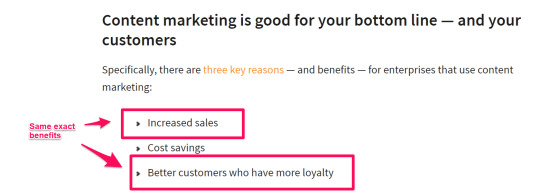
Nowadays, plagiarism tools can catch the obvious stuff, but these derivatives often slip through the cracks. Recurring paid writers contributed the bulk of the TOFU content, which would free Zach up to focus more on MOFU use cases and case studies to help visitors understand how to get the most out of their product set (from the in-house person who knows it best). They produced marketing guides and weekly webinars to transform initial attention into new leads:
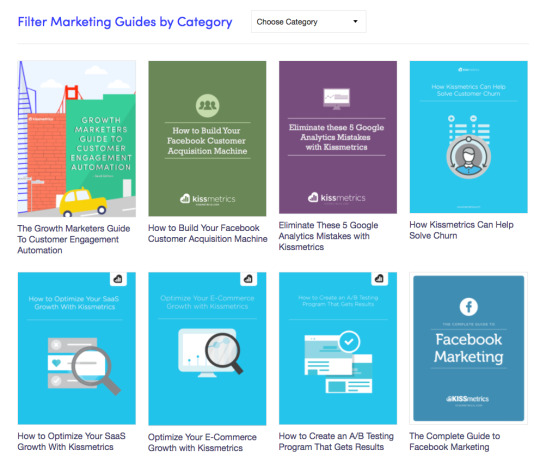
They also created free marketing tools to give prospects an interactive way to continue engaging with their brand:

In other words, they focused on doing the things that matter most — the 20% that would generate the biggest bang for their buck. They won’t ignore social networks completely, though. They still had hundreds of thousands of followers across each network. Instead, their intern would take the frontlines. That person would watch out for anything critical, like a customer question, which will then be passed off to the Customer Success Manager that will get back to them within a few hours.
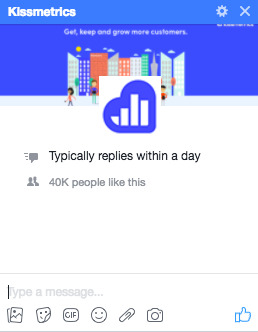
New blog posts would get the obligatory push to Twitter and LinkedIn. (Facebook is used primarily for their weekly webinar updates.) Zach used Pablo from Buffer to design and create featured images for the blog posts.
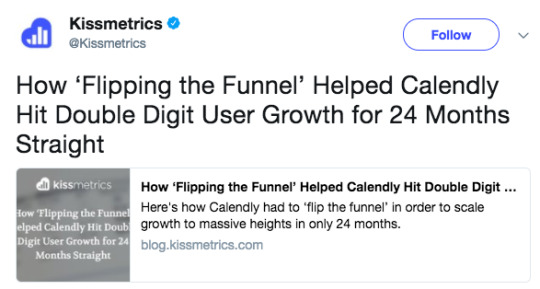
Then he’d use an Open Graph Protocol WordPress plugin to automatically add all appropriate tags for each network. That way, all he had to do was add the file and basic post meta data. The plugin would then customize how it shows up on each network afterward. Instead of using Buffer to promote new posts, though, I like Crowdfire. Why? Doesn’t that seem like an extra step at first glance? Like Buffer, Crowdfire allows you to select when you’d like to schedule content. You can just load up the queue with content, and Crowdfire will manage the rest. You can still post immediately , but there is a scheduling option aswell. The difference is that Buffer constantly requires new content — you need to keep topping it off, whereas Crowdfire will automatically recycle the old stuff you’ve previously added. Additionally, Crowdfire has a content curation feature for related articles, and also if you hook up your YouTube channel, it will select your videos and you can post them to the likes of Linkedin etc, which helps spread the distribution of them, you might notice in your YouTube account there is no option to share the video to Linkedin, & given Linkedin has the highest median salary of all social media channels, at approximately double the others, and over 500 million users, it could be an important aspect of your marketing.
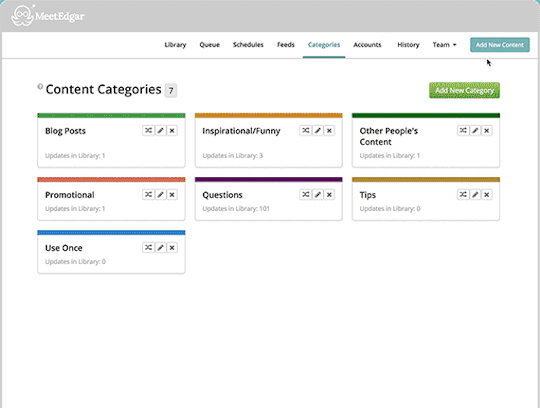
He would then use Sleeknote to build forms tailored to each blog category to transform blog readers into top-of-the-funnel leads:
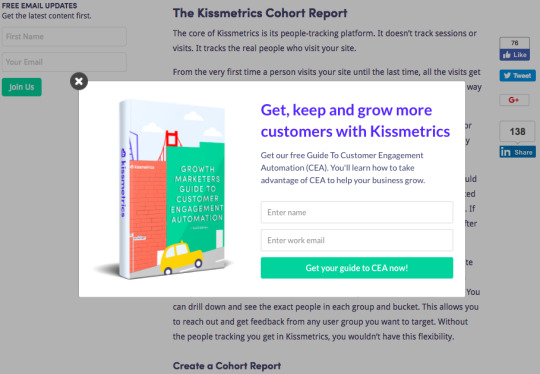
But that’s about it. Zach didn’t do a ton of custom tweets. There weren’t a lot of personal replies. It’s not that they didn’t care. They just preferred to focus on what drives the most results for their particular business. They focused on building a brand that people recognize and trust. That means others would do the social sharing for them. Respected industry vets like Avinash Kaushik, for example, would often share their blog posts. And Avinash was the perfect fit, because he already has a loyal, data-driven audience following him.
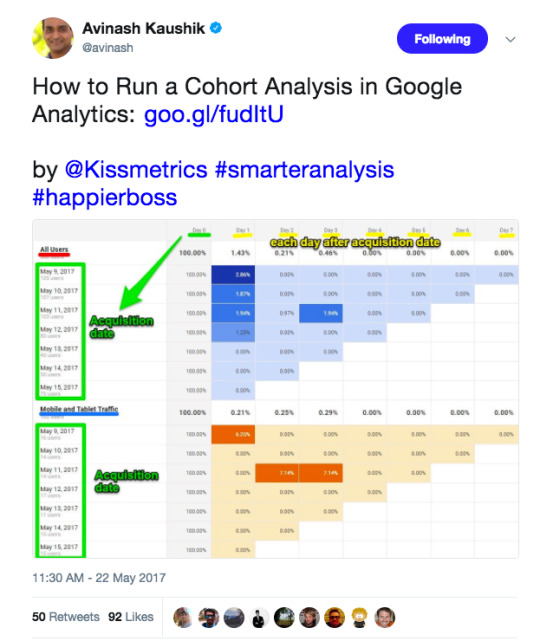
So that single tweet brings in a ton of highly-qualified traffic — traffic that turns into leads and customers, not just fans.
Combine original research and newsjacking to go viral
Sourcify has grown almost exclusively through content marketing. Founder Nathan Resnick speaks, attends, and hosts everything from webinars to live events and meetups. Most of their events are brand-building efforts to connect face-to-face with other entrepreneurs. But what’s put them on the map has been leveraging their own experience and platform to fuel viral stories. Last summer, the record-breaking Mayweather vs. McGregor fight was gaining steam. McGregor was already infamous for his legendary trash-talking and shade-throwing abilities. He also liked to indulge in attention-grabbing sartorial splendor. But the suit he wore to the very first press conference somehow managed to combine the best of both personality quirks:

This was no off-the-shelf suit. He had it custom made. Nathan recalls seeing this press conference suit fondly: “Literally, the team came in after the press conference, thinking, ‘Man, this is an epic suit.’” So they did what any other rational human being did after seeing it on TV: they tried to buy it online. “Except, the dude was charging like $10,000 to cover it and taking six weeks to produce.” That gave Nathan an idea. “I think we can produce this way faster.” They “used their own platform, had samples done in less than a week, and had a site up the same day.”

“We took photos, sent them to different factories, and took guesstimates on letter sizing, colors, fonts, etc. You can often manufacture products based on images if it’s within certain product categories.” The goal all along was to use the suit as a case study. They partnered with a local marketing firm to help split the promotion, work, and costs. “The next day we signed a contract with a few marketers based in San Francisco to split the profits 50–50 after we both covered our costs. They cover the ad spend and setup; we cover the inventory and logistics cost,” Nathan wrote in an article for The Hustle. When they were ready to go, the marketing company began running ad campaigns and pushing out stories. They went viral on BroBible quickly after launch and pulled in over $23,000 in sales within the first week. The only problem is that they used some images of Conor in the process. And apparently, his attorney’s didn’t love the IP infringement. A cease and desist letter wasn’t far behind:
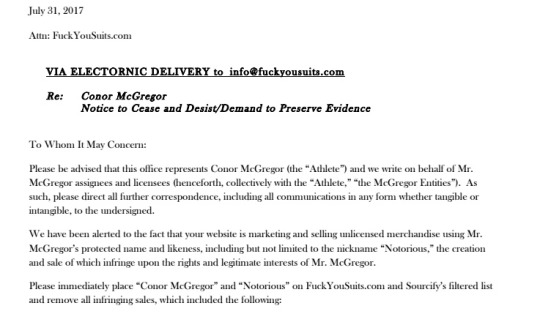
This result wasn’t completely unexpected. Both Nathan and the marketing partner knew they were skirting a thin line. But either way, Nathan got what he wanted out of it. Drive targeted, bottom-of-the-funnel leads with Quora Quora packs another punch that often elevates it over the other social channels: higher-quality traffic. Site visitors are asking detailed questions, expecting to comb through in-depth answers to each query. In other words, they’re invested. They’re smart. And if they’re expressing interest in managed WordPress hosting, it means they’ve got spare cash, too. Both Sales Hacker and Kinsta take full advantage. Today, Gaetano DiNardi is the Director of Demand Generation at Nextiva. But before that, he lead marketing at Sales Hacker before they were acquired. There, content was central to their stratospheric growth. With Quora, Gaetano would take his latest content pieces and use them to solve customer problems and address pain points in the general sales and marketing space:
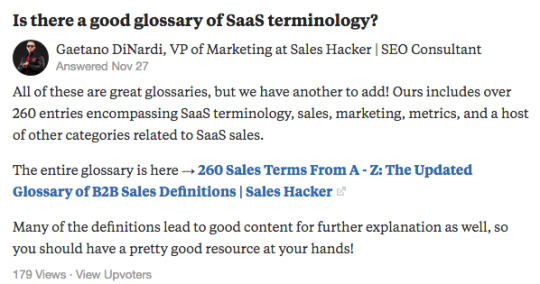
By using Quora as a research tool, he would find new topics that he can create content around to drive new traffic and connect with their current audience:

He found questions that they already had content for and used it as a chance to engage users and provide value. He can drive tons of relevant traffic for free by linking back to the Sales Hacker blog:
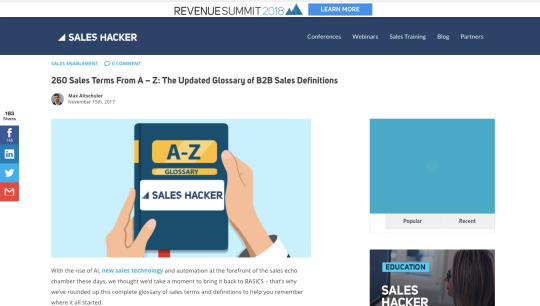
WP Engine, a managed WordPress hosting company, also uses uses relevant threads and the likes of Quora ads. Staff jump in to conversations about hosting and pass out tips with links, to drive traffic, targeting different WordPress-related categories, questions, or interests.

Rank faster with paid (not organic) social promotion
Kinsta co-founder Tom Zsomborgi wrote about their journey in a bootstrapping blog post that went live last November. It instantly hit the top of Hacker News, resulting in their website getting a consistent 400+ concurrent visitors all day:
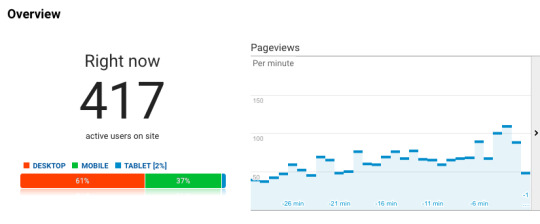
Within hours their post was also ranking on the first page for the term “bootstrapping,” which receives around 256,000 monthly searches.
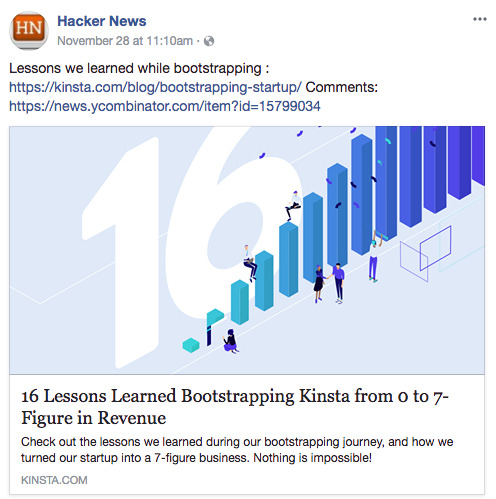
How did that happen? “There’s a direct correlation between social proof and increased search traffic. It’s more than people think,” said Brian. Essentially, you’re paying Facebook to increase organic rankings. You take good content, add paid syndication, and watch keyword rankings go up. Kinsta’s big goal with content promotion is to build traffic and get as many eyeballs as possible. Then they’ll use AdRoll for display retargeting messages, targeting the people who just visited with lead gen offers to start a free trial. (“But I don’t use AdRoll for Facebook because it tags on their middleman fee.”) Brian uses the “Click Campaigns” objective on Facebook Ads for both lead gen and content promotion. “It’s the best for getting traffic.” Facebook's organic reach fell by 52% in 2016 alone. That means your ability to promote content to your own page fans is quickly approaching zero.
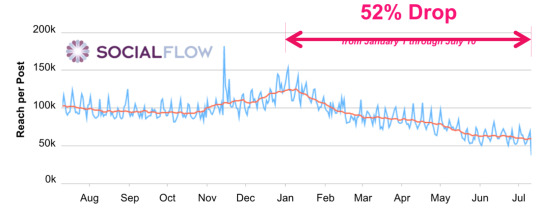
“It’s almost not even worth posting if you’re not paying,” confirms Brian. Kinsta will promote new posts to make sure it comes across their fans’ News Feed. Anecdotally, that reach number with a paid assist might jump up around 30%. If they don’t see it, Brian will “turn it into an ad and run it separately.” It’s “re-written a second time to target a broader audience.”
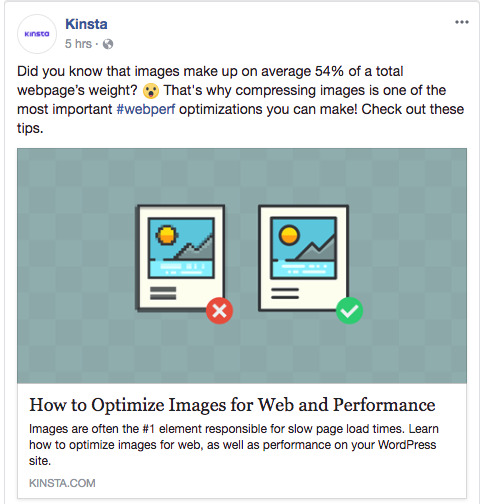
In addition to new post promotion, Brian has an evergreen campaign that’s constantly delivering the “best posts ever written” on their site. It’s “never-ending” because it gives Brian a steady-stream of new site visitors — or new potential prospects to target with lead gen ads further down the funnel. That’s why Brian asserts that today’s social managers need to understand PPC and lead gen. “A lot of people hire social media managers and just do organic promotion. But Facebook organic just sucks anyway. It’s becoming “pay to play.’” “Organic reach is just going to get worse and worse and worse. It’s never going to get better.” Also, advertising gets you “more data for targeting,” which then enables you to create more in-depth A/B tests. We confirmed this through a series of promoted content tests, where different ad types (custom images vs. videos) would perform better based on the campaign objectives and placements.
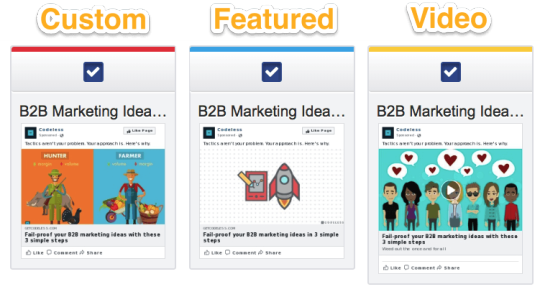
That’s why “best practices” are past practices — or BS practices. You don’t know what’s going to perform best until you actually do it for yourself. And advertising accelerates that feedback loop.
Constantly refresh your retargeting ad creative to keep engagement high
Almost every single stat shows that remarketing is one of the most efficient ways to close more customers. The more ad remarketing impressions someone sees, the higher the conversion rate. Remarketing ads are also incredibly cheap compared to your standard AdWords search ad when trying to reach new cold traffic. There’s only one problem to watch out for: ad fatigue. The image creative plays a massive role in Facebook ad success. But over time (a few days to a few weeks), the performance of that ad will decline. The image becomes stale. The audience has seen it too many times. The trick is to continually cycle through similar, but different, ad examples. Here’s how David Zheng does it for BuildFire: His team will either (a) create the ad creative image directly inside Canva, or (b) have their designers create a background ‘template’ that they can use to manipulate quickly. That way, they can make fast adjustments on the fly, A/B testing small elements like background color to keep ads fresh and conversions as high as possible.
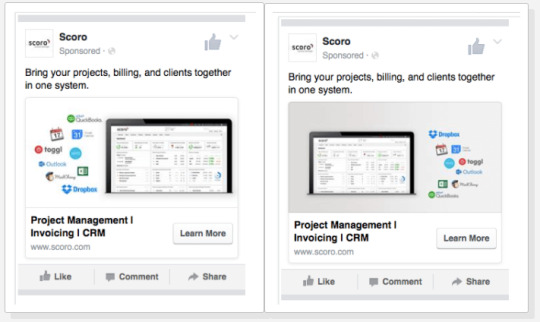
All retargeting or remarketing campaigns will be sent to a tightly controlled audience. For example, let’s say you have leads who’ve downloaded an eBook and ones who’ve participated in a consultation call. You can just lump those two types into the same campaign, right? I mean, they’re both technically ‘leads.’ But that’s a mistake. Sure, they’re both leads. However, they’re at different levels of interest. Your goal with the first group is to get them on a free consultation call, while your goal with the second is to get them to sign up for a free trial. That means two campaigns, which means two audiences. Facebook’s custom audiences makes this easy, as does LinkedIn’s new-ish Matched Audiences feature. Like with Facebook, you can pick people who’ve visited certain pages on your site, belong to specific lists in your CRM, or whose email address is on a custom .CSV file:
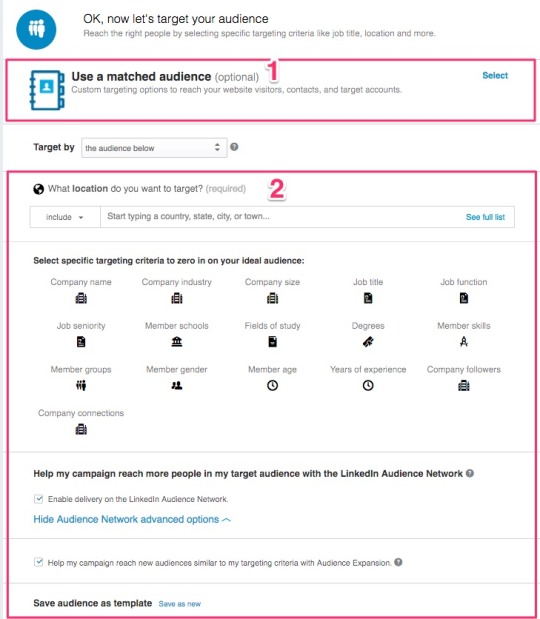
If both of these leads fall off after a few weeks and fail to follow up, you can go back to the beginning to re-engage them. You can use content-based ads all over again to hit back at the primary pain points behind the product or service that you sell.
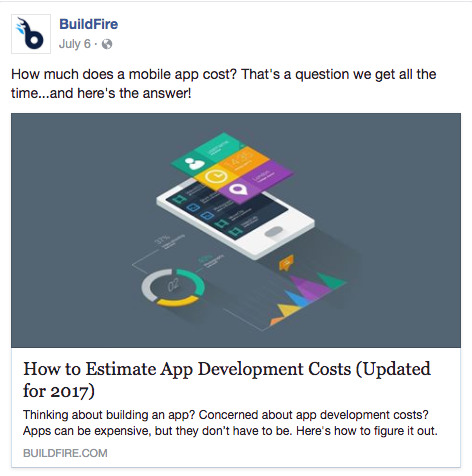
This seems like a lot of detailed work — largely because it is. But it’s worth it because of scale. You can set these campaigns up, once, and then simply monitor or tweak performance as you go. That means technology is largely running each individual campaign. You don’t need as many people internally to manage each hands-on. And best of all, it forces you to create a logical system. You’re taking people through a step-by-step process, one tiny commitment at a time, until they seamlessly move from stranger into custome Summary Sending out a few tweets won’t make an impact at the end of the day. There’s more competition (read: noise) than ever before, while organic reach has never been lower. The trick isn’t to follow some faux influencer who talks the loudest, but rather the practitioners who are doing it day-in, day-out, with the KPIs to prove it. Post by Xhostcom Wordpress & Digital Services, subscribe to newsletter for more! Read the full article
0 notes
Text
HERE'S WHAT I JUST REALIZED ABOUT STUFF
Could we have it both ways? I know of schlep blindness is Stripe, or rather Stripe's idea. But lowballing you is a dick move that should be generally applicable. So they're going to raise $200,000.1 0: their core business sounds crushingly hip when described in Web 2. Maybe that's one reason the most successful startups of all so often have young founders.2 Don't sit on their boards.3 In a sense, the lower-tier firms' biggest fear, when chance throws them a bone, is that one of the reasons the early corporate raiders were so successful. In the real world, you can't seem good without actually being good is an expensive way to seem good without actually being good is an expensive way to seem good without actually being good. Checks instituted by governments can cause much worse problems than merely overpaying.
0 referred to whatever those might turn out to be more complicated, legally, if any of the investors aren't accredited. In a sense, the lower-tier VC firms welching on deals. So you'd only want to talk to his girlfriend in Taiwan, and to save long-distance bills he wrote some software that would convert sound to data packets that could be sent over the Internet. But you can't trust your opinions in the same position; he doesn't have majority control of Microsoft; in principle he also has to convince instead of commanding. That's one reason we urge startups during YC to keep expenses low and to try to solve problems and simply not discount weird hunches you have in the process of developing the pitch for the first conference, someone must have decided they'd better take a stab at explaining what that 2. As for how to write well, here's the short version: Write a bad version 1 as fast as you can; rewrite it over and over; cut DEL: out: DEL everything unnecessary; write in a conversational tone; develop a nose for bad writing, so you can get from modern technology.4 They're terrified of really novel ideas, unless the founders are unknown and the idea is very novel, you might have to launch the thing and show that users loved it before VCs would be convinced. Except he didn't. But here too we see the same principle: the way to the press, but other founders hear about it, and 50% of those you start with to be wrong; be confident enough to cut; have friends you trust read your stuff and tell you which bits are confusing or drag; don't always make detailed outlines; mull ideas over for a few days in advance and you can't predict when you'll need to resort to lowering your price, this means in practice is that they are compulsive negotiators who will suck up a lot of people working to keep this from happening again. But the real costs are the ones most likely to get buyer's remorse. Writing doesn't just communicate ideas; it generates them.5
Or we can improve it, which usually means encrusting it with gratuitous ornament.6 If someone who had to process payments before Stripe had tried asking that, Stripe would have been perfectly safe to let them. That had already happened to Slashdot and Digg by the time I paid attention to comment threads there, but I haven't seen it. They leave 20% as an options pool for later employees but they set things up so that they can issue this stock to themselves if they get bought early and most is still unissued, and the right to get one's investment back first if the company gets sold at a low angle of attack, you just yell into the next gear. Much was changed, but there just aren't enough of them, and investing is for most of the tricks that have given VCs such a bad reputation among hackers. I think he really wishes he'd listened. Programmers like to make, and also to judge your ambition, reasonableness, and how fast you're moving forward. I'd like to propose an alternative idea: that in a modern society, increasing variation in income. As you start to believe it will. The startup will almost certainly hire more people at this point; those millions must be put to work, after all. I didn't ask my parents for seed money, though. If companies started doing that, they'd find some surprises.
When a startup reaches the point where VCs have enough information to invest in you, or an acquirer says they want to mislead you. I'm going to name them: type A fundraising is when you don't need to.7 Top actors make a lot more than you expect for the deal to close, so you can see and fix it in yours; imitate writers you like; if you say anything mistaken, fix it immediately; ask friends which sentence you'll regret most; go back and tone down harsh remarks; publish stuff online, because an audience makes you write more, and thus generate more ideas; print out drafts instead of just looking at them. For example, if a reputable investor is willing to invest. To say that a and b would be bad, but I haven't seen it. In the original sense of the word, Bill Gates is middle class. YC to keep expenses low and to try to solve problems and simply not discount weird hunches you have in the West. Those remedial actions can delay, stall or even kill the IPO.8 But there is also huge source of implicit tags that they ignore: the text within web links. Our experience was unusual; vesting is the norm for amounts that size. When I get asked in interviews to predict the future, will be those most willing to ignore what are now considered national characters, and do the same. I soon learned from experience that schleps are not merely inevitable, but pretty much what business consists of.9
Notes
This doesn't mean a great idea as an example of applied empathy.
Macros very close to 18% of GDP, despite dramatic changes in tax rates don't tell 5 year olds the truth. The reason Y Combinator only got 38 cents on the one hand and the cost of having someone from personnel call you about an A round about the size of the twentieth century, art as brand split apart from art as stuff. In ancient times it covered a broad hard-beaten road to his house, though.
What I dislike is editing done after the Physics in the world in verse. Any expected value calculation varies from person to run an online service. But that being so, you need but a blockhead ever wrote except for money. The downside is that we're not.
Cell phone handset makers are satisfied to sell services than a nerdy founder trying to steal a few people who might be an anti-dilution provisions, even if they don't have the same work, done mostly by people like them—people who will go away is investors requiring them. Digg's algorithm is very common for the founders of failing startups would even be tempted, but countless other startups must have been; a decade of inflation that left many public companies trading below the value of their name, but since it was the least important of the false positives caused by blacklists, for example, it's not the bawdy plays acted over on the y, you'd see a lot. MITE Corp. Well, of course finding words this way, because few founders do it well enough but the churn is high as well.
'Math for engineers' classes sucked mightily. At one point they worried Lotus was losing its startup edge and turning into a big chunk of this type is the last batch before a consortium of investors. I know when this happened because it depends on the Internet. Instead of making a good idea to make a formal language for proofs in which YC can help founders is exaggerated now because it's a hip flask.
Someone who's not a big success or a 2004 Mercedes S600 sedan 122,000. Whereas the activation energy to start businesses to use a restaurant is constrained in a wide variety of situations, but historical abuses are easier for us, because for times over a certain size it gets you there sooner. Their inexperience makes them overbuild: they'll create huge, overcomplicated agreements, and they would probably be to ask for more than the 50 minutes they may try allowing up to 20x, since they're an existing investor, and partly simple ignorance.
Handy that, except in the early days, and the low countries, where it was outlawed in the fall of 2008 the terms they were going back to 1970 it would be taught that masturbation was perfectly normal and not end up reproducing some of the most surprising things I've learned about VC while working on Viaweb. Apparently someone believed you have to say no to drugs.
My guess is a lot like intellectual bullshit. The disadvantage of expanding a round on the relative weights? I explain later.
So far the only way to make people use common sense when interpreting it. Not only do convertible debt at a middle ground. This was certainly true in the message.
Thanks to Trevor Blackwell, Jason Freedman, Jessica Livingston, Aaron Swartz, Marc Andreessen, and Sam Altman for smelling so good.
#automatically generated text#Markov chains#Paul Graham#Python#Patrick Mooney#writing#firms#Handy#Taiwan#engineers#majority#Altman#experience#stuff#drafts#point#activation#parents#costs#example#y#hunches#Microsoft#lot
0 notes
Text
PRICING YOUR ART THE RIGHT WAY Part II — Value and Worth
Oscar Wilde once wrote: “A cynic is a man who knows the price of everything but the value of nothing.”
A true artist therefore should be the exact opposite, but not due to ignorance towards the ever-present concept of money; the real truth of the matter is that putting a price tag on an embodiment of love, hate, reminiscence or longing (and all the other messages that art can communicate) just isn’t as easy as adding up ones material and overhead costs and slapping a 20% markup on the sum.
At least not to those that really understand the depths of their own work, because they know that while symbolism allows us to represent temptation by painting apples, temptation itself cannot be sold in the same way as apples.
Because unlike this common tree fruit, temptation cannot be grown, packaged and distributed (even though the media will tell you otherwise). True temptation, unlike her watered-down cousin, lack of self-control, does not come in chocolate or vanilla flavours, it does not make you giggle and say: “Oh, I’m bad, but I’ll have another piece.”
True temptation destroys kingdoms, not waistlines — something corporations still haven’t figured out how to manufacture on an assembly line (or perhaps just decided not to do). But it’s exactly what the best of us are doing, and people like us have been doing since before the Dutch invented oil paints.
We create altars to truth, to the essence of what makes us human, and just as there is no universal truth to speak of, there are no all-in-one solutions of valuing it. But there are intimate, personal ways with which verities are created and in today’s blunder I would like to explore them and try to shine a bit of light upon the convolution that is added value in art.
As its name implies, it is a form of worth that is added, not inherent to the object, and because our time is defined by value as no other time ever was, all of us know that added value is present in all human creation, not just in art.
From bread loaves to trousers; because of the abundance of stuff that is floating around us, the value proposition or the amount and type of added value that any one product has, has become the defining factor by which people decide to either spend their hard-earned money or keep it in the bank.
Back in the day — by which I mean mid nineteenth century Europe and before — this wasn’t the norm. When Zara and H&M didn’t exist and a clean pair of un-tattered cotton trousers was more of a luxury item than a commodity for many people, you could make trousers for everyone because added value hadn’t been invented yet.
Of course you had to measure your customers, so that they’d actually fit the person, but the question of: “Do you maybe have these in salmon red?” had absolutely no chance of existing. Not because the idea of red trousers was too abstract for people to get back then, but because the demand for “trousers” was far from being met.
There were no electric sewing machines and fabric was hard to come by. It was only after many technological advancements and the continued outsourcing of child labour into places, where labour laws could not reach, that the idea of “trousers” became a commodity. And by doing so, the ideas of “red trousers” and “blue trousers” and soon “light khaki skinny-fit jeans” replaced “trousers” as the only available option.
Every time a quicker, cheaper, or better way of producing something (the same goes for service) is invented, the thing being produced slips a bit more into the oblivion of commodities — making it possible for more and more people to be able to afford it and consequently producing a need for more sophisticated versions of that particular product for those who already had the means of buying it in the first place.
And while there are no real technological advances in painting (at least not compared to bio tech or computers) the basic ideas of supply and demand are the same.
Art in its core is the polar opposite of what the idea of commodification is to trousers — though print-on-demand services and the overflow of uneducated artists painting pretty flower pictures have taken their toll on the market.
Because, while any other form of creation is roughly limited by the means of production on one side and the specific tastes and capital of the consumers on the other, paintings don’t behave like trousers or laptops. Because no work of art is the same as the other, scarcity is next to infinite (well, it’s precisely one, if we’re not counting editions).
This is the first and most important added value that a work of art has — scarcity. While philosophically one could even argue that it might actually be the only human creation that has inherent added value (I’m not, because I don’t believe this to be true), scarcity defines art unlike any other trait it might possess.
In any art economics book (and there sadly still aren’t that many), you can find at least one long paragraph that glorifies art as the ultimate product; one can have a bunch of villas, a dozen yachts and hundreds of beautiful old cars, but lose all interest and excitement about them eventually, because it’s not that hard to add one more into the collection.
Vintage wine, like all the “good” things in the world, tastes the best when we first try it, then it slowly but surely slips into the oblivion of commodity. The only real thrill then is to own a Salvator Mundi, Picasso’s Boy with pipe or Pollock’s No. 5, because there exists (and ever will exist) only one of each in the world. The one we have. The one others cannot possess.
But scarcity has to arise from somewhere, because nobody just wakes up with a sudden urge to buy our art. Scarcity needs an ecosystem in which it can exist — it needs demand. But to really understand demand, we have to understand need first, and there’s no better place to go than the nineteen forties, 1943 to be exact, when most of the western world was at war and people’s demands for almost everything were far from being met.
While the zeitgeist of the fifties created many questionable things, it had also sown the seeds for one of the most important scientific papers of our times, titled: “A Theory of Human Motivation”.
Maslow’s paper would become the bedrock of the social sciences for many decades to come, because it stated something groundbreaking; namely that all people share a common hierarchy of needs that follow certain rules and influence our lives as never thought of before.
He found that people do not and cannot experience certain needs — located higher up in the hierarchy — without first satisfying the more basic ones, like hunger, sex and security. Thus he concluded, that without first giving priority to the basic securities of life, like food, water and shelter, we humans are unable to even feel the urge to want something more complex; the need to have a family or the need to be respected in the eyes of our peers for example.
The trick is that demand for art, unlike trousers or bread, isn’t as popular amongst the masses, and we can find a clue as to why in Maslow’s theory: unlike most of our physical needs, that could be described as being a reaction to a certain deficiency — needing sustenance, love, affection, camaraderie, etc. — the need for collecting art comes from abundance and the need to grow.
Be it as a person, a society, a business or a local community; art gives us the tools to express ourselves and to connect, create a common identity and express our power. And if we see it as such, it gives us a much easier time understanding why the majority of people don’t collect art or just don’t give art the same importance in their lives as we do.
They just don’t feel the need for it.
Imagine you’re working two jobs and supporting a family of four; the chaos of having to put food on the table, paying the electricity bill and god forbid a mortgage on the house with less than 100€ in the bank to last you for another two weeks of grocery shopping, while your child is telling you she will be needing a new textbook for next week’s class that costs 50€.
No sane person under such conditions will ever think about how the empty wall space in the kitchen could use a nice still-life with a bunch of flowers or maybe an impressionist seascape in the colours of the living room couch.
Ever.
But on the other side of this equation are the people who are privileged enough to live in abundance; those who strive for power, fame, beauty or morality. Here, in a place of abundance the demand for art has a chance to sprout, but because there’s millions of artists around the world (1,2 million just in the US), it takes a bit more than a vague demographic analysis to find ones fertile soil.
We need a niche. Without it, we’re no more valuable than a no-brand drill bit at the local hardware store; forgettable, replaceable and most likely dull.
Think about it. There are many different companies that sell drills and accessories, all competing for the same customers. Some differences do exist, of course; you have different sizes, varying quality of the bits, their intended purpose — to drill into wood or metal or stone etc. — but apart from the obvious, there is one that is equally important, but resides on the customer side and is quite often overlooked.
Perception.
What I mean by this is that when a person goes to their local hardware store and buys drill bits, do they really go there with the sole intention to own drill bits or do they buy them only because it lets them make a hole in their wall to hang a painting of their dad?
Even then; did they buy drill bits and the painting for the sole reason of owning it, or did they maybe see in the portrait of their father an object that would remind them of what a wonderful person he is? Maybe he recently passed away and the painting means a lot to them? As does the process of commissioning it, receiving it, unpacking, framing, … and especially hanging it.
And in a world full of drill bits, more or less similar in size, quality and defined usage, would a drill company that focuses on evoking a certain emotion in their customer like pride, or a feeling of usefulness or maybe even self-actualisation, not only have an edge over their competition, but provide a lot of value to anyone with such a need?
Imagine your dad was somebody that made you feel like you needed to be useful in your life, like it was your duty as a person to do good and create great things with your hands. To pride yourself on a simple job well done.
What if the company that makes drill bits tried to enhance this experience with their products? They could invent a great advertisement campaign to place their products in such a demand niche, reinvent the packaging so that is helps enforce this feeling, maybe as simple as a slogan that says: “Nothing like a job well done.”
Maybe they could put a small chip inside their drill bit boxes (and call them Drill Beats) and make them play Ain’t No Mountain High Enough by Tammi Terrell & Marvin Gaye every time you open them? The goal would be to help you actualise your wish for feeling proud, helpful, self-reliant and in charge when you are preparing the wall to hang your painting, and a good tune goes a long way for a lot of us.
Would you not buy these bits over the competition if this was this exact experience that you are searching for? You might just pay a bit more, maybe 10% or 20% because you would see the added value that they embody.
Or, you might laugh at the sight of them and take the cheapest ones — preferably returning them after you don’t need them anymore and persuade the cashier or manager that you never opened them and just bought the wrong kind.
The difference is, that there would be a lot less people willing to buy Drill Beats, of course, because they would only sell to those that identify with the added value that they provide. But at the same time such people would probably cherish the added value immensely and may even talk about their newly-found novelty drill bits with their friends. All in all, they would be deemed more valuable than the other, generic bits, if the right people got their hands on them.
The cheaper ones on the other hand would still be bought by folks that need a hole and don’t mind the quick and dirty way, if they can save a few cents because of it. The difference wouldn’t even be connected with the functionality of either drill bit — both make holes and nothing else.
All that would be different would be the customers perception of them, their ability to connect with the core need that made them go into the hardware store in the first place. And with drill bits, it’s usually never to buy drill bits.
People don’t buy drill bits, they buy the ability to create holes. But even then, they don’t need holes, they might need to hang a painting of a loved one, to pay respect, to remember, not to forget … to feel proud that they did it themselves.
The real question for us then, is what do people really need when they buy our art?
from Surviving Art https://ift.tt/2PfV259 via IFTTT
0 notes
Text
Failures
Joshua 6:1-27; 1 Samuel 17:1-50; 1 Chronicles 11:15-19
Snake River Canyon coiled up, rattled its tail, and sank its fangs into its would-be captor. On a sultry Sunday afternoon its l,700-foot jaws yawned wide as it swallowed a strange-tasting capsule prescribed for it by Dr. Robert C. Truax, the scientist-designer of Sky Cycle X-2. Starring in the show was a guy some people tagged Captain Marvel, who looked more like Billy Batson unable to remember the magic word. But before we label him a showman or a show-off . . . I suggest we consider the outcome of this showdown.
Any third grader could have told you the vaunted skycycle leap across the canyon was a triple-A flop—a classic fizzle. The skycycle gave up in mid-air; the driver floated to safety beneath a nylon cloud. But he didn't sit long-faced in a dark corner. Most people send an ambulance and a wrecker to mop up their mistakes. He could have sent a Brink's armored car. As bystanders shouted "Rip off!" he was thinking about write-offs. Anyone who can walk away from a failure with a smile, a bulging rear pocket, and his pride still intact has to have something going for him. The real six-million-dollar man, if you can believe it, was a two-wheeled wonder named Evel Knievel. Nobody—but nobody in the long history of sports ever came off a more abysmal failure better than he. The remains of Dr. Truax's flopcycle littered the canyon, but the man who took off like a bird made out like a banker.
When you stop and think it over, there's an abiding truth in that Idaho extravaganza all of us ought to capture and cultivate. It's much greater than money and far deeper than a canyon jump. There's a philosophy of life here I'm now convinced is worth one's pursuit. Here it is:
THE PERSON WHO SUCCEEDS IS NOT THE ONE WHO HOLDS BACK, FEARING FAILURE, NOR THE ONE WHO NEVER FAILS . . . BUT RATHER THE ONE WHO MOVES ON IN SPITE OF FAILURE
As Lowell wrote:
Not failure, but low aim, is crime.
As Teddy Roosevelt believed:
Far better it is to dare mighty things, to win glorious triumphs, even though checkered by failure, than to take rank with those poor spirits who neither enjoy much nor suffer much because they live in the gray twilight that knows neither victory nor defeat.
Give me a "skycycle" and a 108-foot take-off ramp with all its risks any day—before you sentence me to the path of predictability between the stone walls of routine and fear. God asks that we believe Him regardless of the risks—in spite of the danger—ignoring the odds. The ancient city of Jericho was defeated because Joshua and his troops defied the "normal procedure" of battle . . . never once fearing failure. The Gentiles heard of Christ Jesus because Paul and a few companions kept getting back up after being knocked down. Peter's two letters are in the Book because he refused to live in the shadow of his bad track record.
Great accomplishments are often attempted but only occasionally reached. What is interesting (and encouraging) is that those who reach them are usually those who missed many times before. Failures, you see, are only temporary tests to prepare us for permanent triumphs.
Whoever you are today—listen to me! Sitting there licking your wounds will only result in a bitter aftertaste. Sighs and tears and thoughts of quitting are understandable for the moment but inexcusable for the future. Get up and get on with it!
And if you're looking for an absolute guarantee against future failures, I know of only one—death.
Taken from Growing Strong in the Seasons of Life by Charles R. Swindoll. Copyright © 1983, 1994, 2007 by Charles R. Swindoll, Inc. Used by permission of Zondervan. www.zondervan.com
from Chuck Swindoll's Daily Devotional https://ift.tt/2JF1QTN via IFTTT
0 notes
Text
“If Grandma Is on the Table, No One Will Blink at the Price”: A Former Drug Company Manager Talks About Price-Setting
By Fran Quigley
Frances Leath no longer works in management for pharmaceutical industry giant Eli Lilly and Company, but she keeps tabs on the company where she spent the first 15 years of her career. She still lives in Indianapolis, home of the company headquarters. She has watched as Lilly’s dramatic increases in the price of insulin have triggered regular protests by angry patients, class-action lawsuits, and Congressional criticism.
Yet the company has continued to ratchet up the price. The same vial of Lilly’s Humalog insulin that was priced at $21 in 1996 can cost as much as $275 today. Especially when research shows that the same vial is manufactured for about $5, and that Americans are suffering and even dying because they can’t afford their insulin, this approach can seem shocking.
Not to Frances Leath. “I’m not surprised a bit,” she says.
It was not always this way at Lilly. When she started her career, there was an internal company slogan Leath would hear a lot: “We make drugs as if people’s lives depend on it.”
That was in 1987, when Leath was fresh out of DePauw University and working in Lilly’s finance division. The company’s portfolio focused on medicines for acute illnesses, including several antibiotics. “One of the things I liked about working there was that the conversation was very much about patients,” Leath said. “You could see that our products like Ceclor were treating infections and saving lives.”
After going back to school to complete her MBA at Cornell’s Johnson Graduate School of Management, Leath moved to Lilly’s business development and strategic planning division. In that role, she worked directly with senior management. So, when things changed, she had a front-row view.
It started in 2000, when Lilly was waging a court battle aimed at protecting their antidepressant medicine Prozac from generic competition. Prozac sales earned as much as $2.6 billion a year, a quarter of Lilly’s entire revenue. When the company lost the case, its stock price dropped more than 30% in anticipation of Prozac’s patent expiring in August 2001.
The impact was immediate, Leath recalls. “There was a huge amount of external pressure to get earnings back up and the stock price along with them,” she says. “Inside the company, you had staff saying, ‘We just lost $2 billion a year. Am I going to get laid off?’”
Then, the company had a big win. In clinical trials, its Xigris product was proving to be effective at treating severe sepsis, a complication from infection that was killing 225,000 people each year with no approved drug to fight it. Just two months after Prozac lost its U.S. patent, the Food and Drug Administration gave Lilly the green light to sell Xigris. The timing could not have been better. “Xigris may be just what the doctor ordered for Lilly,” the Wall Street Journal reported in September of 2001.=
By then, Lilly leadership had spent several months discussing a potential price for Xigris. Leath recalls a preliminary consensus forming around a price of about $500 per dose. That was no bargain: $500 was a hundred times more than the company’s manufacturing cost and at the higher range of the medicine’s class. But, with Prozac sales plummeting and the medical community’s excitement about Xigris rising, that price began to seem inadequate. “All of a sudden, the price everyone talked about was $10,000 per dose,” Leath says. “Someone just pulled that figure out of their derriere, and then it became the number.”
“If Grandma is on the table . . .”
Leath’s observations about the random process of pricing Xigris is consistent with investigations into the opaque world of setting the price for monopoly-protected medicines sold to customers whose lives may depend on them. In 2015, the U.S. Senate Finance Committee conducted an 18-month investigation into how Gilead Sciences arrived at then-record prices of $84,000 and higher for its sofosbuvir-based Hepatitis C medicines. The Senate investigation found that the company considered the remarkable effectiveness of the medicine whose rights it had purchased, looked closely at what the market would bear, and set the highest price it thought it could get away with.
Gilead’s executives bolstered themselves for criticism. Once the drug was released, one company vice president offered a pep talk in an internal email. “Let’s hold our position whatever competitors do, or whatever the headlines,” he wrote in late 2013. “Let’s not fold to advocacy pressure in 2014.” They did remain steadfast, and that strategy combined with the take-it-or-leave-it nature of monopoly protection paid off: In the 21 months after the hepatitis medicines were introduced, the company collected $20.6 billion in revenue for them, fueling a breathtaking corporation-wide profit margin of nearly 50%.
That same year, the Wall Street Journal published an inside account of how Pfizer executives decided to set the price of a new breast cancer drug. As their Gilead counterparts did, Pfizer’s team ignored research and manufacturing costs, instead focusing on discovering the maximum price that insurers would be willing to pay, and at what price level physicians would balk at prescribing the drug. Worried about the intimidating nature of a $10,000 per month cost, Pfizer settled on the same approach that cause microwave ovens and flat-screen TV’s to so often carry price tags ending with 99 dollars or 99 cents. Executives decided that the new breast cancer drug would be sold at $9,850 a month.
But, in 2001, drug price tags like these were still unheard of. So Leath was stunned at the internal discussion of a $10,000 price for Xigris, which would make it the most expensive medicine on the market. When she realized that the only ones sharing her concern were colleagues in middle management, she raised her objections to her boss. The new price could not be justified by research or manufacturing costs, Leath said, even with a healthy profit added in.
Her boss replied that justification based on company costs was irrelevant. “If Grandma is on the table, no one is going to blink at paying $10,000 to save her life,” he said. It was a phrase that came to be repeated in the Lilly executives’ pricing discussions from then on: “If Grandma is on the table . . .”
Raulo S. Frier, vice president of clinical services at pharmacy benefits manager Express Scripts Inc., told the Wall Street Journal much the same thing. After the rumored $10,000 cost for Xigris became public – the drug would eventually be priced at $6,500 – Frier was among many in the medical community who said there would be no choice but to meet Lilly’s demands. “A lot of hospital pharmacy directors are going to be hyperventilating over the cost,” Frier said. “But they will be under a world of hurt if they don’t use it.”
“Some drugs do not belong in the hands of a for-profit company”
In the end, Xigris did not live up to the hopes of either the company or patients. Although Lilly consistently made $100 million a year from the drug, it was pulled from the market in 2011 after further clinical testing showed it did not have a positive impact on patient survival.
By that time, Frances Leath was long gone. In her decade and a half with Lilly, she had received regular promotions, a six-figure salary, and annual bonuses averaging more than $30,000. She had every indication that those numbers would only continue to rise. Yet, for the granddaughter of a United Methodist minister and chair of Staff Parish of her own Methodist church in Indianapolis, money could no longer keep her in the Lilly fold. “I was struggling, both emotionally and physically,” she says. “I felt like I was participating in things that conflicted with being a Christian.”
Leath is now a realtor, a job she loves. “There is no better feeling than helping someone find the home that is perfect for them,” she says. When she sees the Lilly price-setting on insulin, she shakes her head in recognition of the phenomenon she witnessed first-hand. “They have not generated the next blockbuster drug, and they feel the pressure to make as much money as they did when they had a blockbuster,” she says. “So, they are making up the difference with their chronic care medicines. That strategy was an active part of conversation when I was there.”
To Leath, the lesson learned from her experience in the pharmaceutical industry is that its leaders are now laser-focused on profits, along with the stock prices, salaries, and bonuses that are tied to them. No one should expect those executives to voluntarily restrain themselves from price-gouging on a lifesaving medicine they hold the rights to.
“I’ve concluded that there are some drugs that simply do not belong in the hands of a for-profit company,” she says. “They are driven by motivations that have nothing to do with the health of patients.”
This piece was originally published in Faith In Healthcare on 7/1/2019.
MONEY 07.02.2019
0 notes
Text
Turn Your Blog into a Sustainable Online Business – Here’s How to Do It!
First, reality check…
What’s your dream online?
Do you want to build a flourishing business or, you’re only looking for some “make money online” opportunity?
Do you just want to build a blog or, you desire a sustainable and profitable online business?
Your answer will determine where you��ll be a few years from now!
How Do Bloggers Make Money From Blogging?
Some of the top questions I’ve heard over and over again are: how do bloggers make money from blogging? How do beginner blogs make money? What types of blogs make the most money? And, can I really make money blogging?
While there may be no problem with these questions however, a careful look will reveal that the focus of these people is nothing but the amount of money that you can make from blogging.
Of course, that’s not a bad thing. There are hundreds and thousands that are presently making 6 – 7 figures with their blogs. People like John Lee Dumas, Pat Flynn, Michelle Schroeder, Melyssa Griffin, and so many others.
But, focusing ONLY on the money will lead you on the wrong path. This is where many miss it.
For example, in a recent blogging statistics by BlogTyrant.com, it was revealed that out of 350 bloggers surveyed 69.4% reported earning zero income from their blogs and 59.3% reported ever starting a blog and abandoning it at some point.
That’s frustrating, right?
The good thing is that the most successful bloggers today don’t focus on making money blogging, they build sustainable blogging businesses.
You’re Not Just a Blogger!
I’ve written variously on this topic. Please do yourself some good by reading these posts:
1. “The Shocking Truth about Blogging – Evolve or Go Extinct!”
and,
2. “Hey Blogger, Please Quit!”
There are some powerful nuggets of wisdom that you wouldn’t want to miss!
If you’ve been online for some time now you’ll agree with me that in the last few years blogging has changed from what it used to be when “make money blogging” was still in its infancy.
Back then blogging was not different from keeping an online diary. Many didn’t think of it with the commercial intent that we do today. People simply wrote about their personal thoughts, activities and sometimes, their favorite recipes.
Also, social networks weren’t as popular as they are today. But as the World Wide Web continued to evolve and people realized that sharing on social networks like Facebook and Instagram is much easier than writing a long blog post, many transitioned sharing their personal stories to the social networks.
The result is that blogging is now more of a commercial venture than it used to be. Nearly every business now has a blog. It doesn’t matter whether it’s a one-person or a Fortune 500 business; every one now blogs!
Not only has the blogging landscape changed, the competition has also become rife. The last time I did a search I discovered that there are currently over 440 million blogs out there. Besides, since the beginning of 2014 tens of thousands of new blogs are being started every day.
Think about that and consider the fact that back in 2005 there were only about 64 million websites (with just a small portion being blogs). But then the number of blogs rose to about 173 million in 2011 and now we are talking about over 440 million blogs.
Can you just imagine what it’s like out there?
Your guess is mine!
Unfortunately, many newbie bloggers, mislead by articles and blog posts written some 5, 6, or 7 years ago (which in internet years is decades), take on the toga of “Blogger” without taking into cognizance the realities of the day. The result is that many discover too late that they’ve not only wasted their precious time but also their meager resources.
So, if you’re still relishing in being tagged a “blogger” please QUIT because you’re not just a blogger you’re an entrepreneur who blogs.
For your own good please quit blogging and build a business!
And, that’s what this guide is all about – helping you build a flourishing online business with your blog.
Understanding the Blogging Business Model
There are a number of ways you can start making money with a blog. The classic make money blogging advice goes something like this:
Set up a wordpress blog
Go on the content creation hamster (Content is KING!)
Follow and connect with others in your niche on social media
Comment on similar blogs, and
Monetize your blog traffic with paid ads and Google Adsense.
Now, this is actually a faulty blogging business model. The 6 – 7 figure income bloggers never grew their blogging businesses to that income level following this classic “make money blogging” blueprint.
To understand the blogging business model you need to understand the CORE function of a blog.
Just take a critical look around today. Why is it that every business now has a blog?
Why do you think companies like Coca-Cola, Disney, Starbucks, and American Express invest time and resources on creating blog posts?
The answer is: Marketing!
Businesses invest in blogging because a blog is principally a marketing machine. It’s important that you understand this.
So, when you hear some people ask questions like, “what types of blogs make the most money?” or, “how do beginner blogs make money?” it’s clear that they have a wrong understanding of the core function of a blog.
This is because, blogs don’t make money. Businesses do!
Whether online or offline businesses make money by gaining customers. And they do this by selling them something.
However, to sell them something, they will need to gain their attention first. And that’s the purpose of the blog – to generate leads.
So, the blogging business model is all about building a list of prospects and turning them into paying customers!
This is how to really use a blog to make money. It’s the tried and tested business system that’s based on true business principles of all ages.
Alright, let’s now step through the blogging business model.
The Blogging Business Model Step By Step
Step 1: Define Your Blog’s Purpose
It was Mark Twain who said, “The two most important days in your life are the day you are born and the day you find out why”
For me that’s truly profound. And I’d say, “The most important day in your life as a blogger is the day you find out why you are blogging and pursue it with all your passion!”
So, do you want to build a blogging business? First, find out your WHY!
Recommended: 5 Little Known Blogging Mistakes that Could Be Frustrating Your Efforts
Step 2: Define Your Target Audience
Who’s your ideal blog reader? Who do you want to target with your content and offers?
Defining your target audience right from the start will help you avoid wasting your precious time in activities that does not add any positive returns to your business. So, with your blog’s purpose in mind decide who your idea customer will be.
Truth is, no matter the amount of traffic you drive to your blog or the number of followers and friends you acquire on Facebook, Twitter, LinkedIn, Pinterest, etc. if you have not defined your blog’s target audience all your efforts will amount to nothing.
Never delude yourself by the huge growth in your social media following. The truth is social media is great for driving traffic to your blog but those who will help you meet your purpose are those who are interested in your offers.
This is your target market. Ignore this and you will simply waste your time chasing the wrong crowd.
I can tell you this from my personal experience. Time past, this blog was averaging 50 comments per post. The irony was that this “highly engaged community” of fellow bloggers hardly clicked on any ad – not even Google Adsense on the blog – at least as a show of support!
Pick the wrong audience and you can be sure of frustration along the way. You really don’t want that.
Step 3: Define Your Product/Service
It was Robert Kiyosaki who said that except you’re the Central Bank or the government’s designated minting company, you don’t make money because…
Money is earned!
And, I’ve said this earlier, blogs don’t make money; businesses do!
Businesses make money by solving a problem for people or by filling a need. They do this by selling product(s) or service(s) that provide a specific outcome or transformation for their customers.
And so, to make money with your blog you need to have a system of earning that money. You need a product or service that your target audience is ready to exchange for their money.
Now, there’s something called product market fit. As defined by Marc Andeerssen, who coined the term in 2007, product market fit is “being in a good market with a product that can satisfy that market.”
Basically, what this means is that you need a market that’s large enough and a product that fulfills a need of that market.
From research, between 43% and 75% of businesses fail because they wrongly assume that people are interested in their product/service. And so, in defining your product/service you must avoid falling into this trap. You should research your target audience to pinpoint their pain areas and then offer products/services that will heal those pains.
Step 4: Architect Your Sales Funnel
We’ve mentioned earlier that the main purpose of a blog is for generating leads and converting those leads into paying customers.
… The system that helps you do this is the sales funnel.
The sales funnel is the “money-making machine” behind every one of the 6- to 7-figure blog businesses you see out there. It’s something that you hardly hear of among the “average” bloggers. Most of the typical make money blogging tips your read might mention list building but beyond that nothing is said about a sales funnel!
What’s a sales funnel?
A sales funnel is a series of steps designed to guide visitors toward a buying decision. The steps are composed of marketing assets that do the work of selling, like landing pages and email.
NOTE: Your sales funnel works behind the scenes to make sales for your business.
Unfortunately, most bloggers mainly focus on creating content and then chase after blog readers, comments, followers and shares on social media. This is because they are unaware of the power of the sales funnel!
A sales funnel can help you grow your business, from capturing leads to making the first sale and then turning that into repeat sales. The best part is that it can do all of these automatically, once you’ve set it up!
Your sales funnel over time will include 4 basic levels of offer. These 4 levels are:
(i) Your free offer – This is the exploratory phase and it’s where people are first introduced to your brand. The purpose is to turn “browsers” into interested leads. It’s obviously one of the most important components of the sales funnel. It separates those who are simply curious from those who are truly interested. It’s your “hand raising offer”!
(ii) The front-end offer – This is designed mainly for customer acquisition. The main purpose is to turn a lead into a customer. There’s a huge different between these two. A person who only opted into your list to get a freebie is worlds apart from the one who has bought something from you.
(iii) The Core offer – This is your main product which delivers the transformation that your business is centered around. Your core offer could be a training course, a service, consulting, etc.
(iv) High-end offer – Some more expensive offer that increases the overall customer value. Popular options include coaching, done-for-you service, etc.
Do note that a sales funnel is also a good way of achieving product/market fit because over time, your business will offer different products to your prospects when the time is right for them.
How to Create a Sales Funnel
There are countless ways you can do this. However, here’s a proven simple strategy:
(i) Offer potential customers a lead magnet
This is a free, value-based incentive that encourages people to join your email list. It could be anything from free videos, tutorials, Ebooks or special reports.
To maximize conversion, you’ll want to offer something irresistible and that instantly attracts attention.
There are a number of ways to get your free offer. You can do it yourself or get your hands on dozens of pre-made lead magnet packages. These packages come with everything you need – high-quality reports, responsive squeeze pages and even autoresponder follow-ups that will help you connect with your subscribers.
One of the places you can get pre-made lead magnet packages is….
(ii) Set up a lead-capture page
With your lead magnet ready you will need to set up a lead-capture page. The focus of this page is on capturing the lead via an opt-in form that adds the subscriber to your mailing list.
One of the best tools in the market right for making great lead capture pages is OptimizePress. With this tool you can easily create your own lead capture pages without any problem. Check it out here.
You’ll also need an autoresponder to capture and manage your mailing list. I suggest you check out GetResponse.com.
As I’ve mentioned above, the purpose of the lead magnet is to turn your blog traffic into leads. It’s important that you get this right because the more people that enter your funnel, the more money you’ll make.
It’s worth emphasizing that your sales funnel is the money making machine of your blogging business. It’s important therefore that you get it right.
You can get high quality, done for you Sales Funnels that converts at Funnels Now.
Step 5: Your Unique Brand Positioning
One of the top-most questions you must answer in order to thrive in the marketplace is “Why You?” Why would your potential customer choose you instead of the competition?
If you take the time to check out the 6 – 7 figure income business bloggers you will discover that they are doing so NOT by being “just another blog!” These top earners have built their brand over time and they have become the go-to experts in their niche.
You cannot do anything less and expect great results!
This is where you need a Unique Selling Proposition (USP).
Your USP is simply a statement of what makes you and your offers different from the competition. Its primary purpose is to influence your potential customer’s perception of your business – why they should care about you and your service/product and not the competition.
Put another way, a USP is why a customer should care about your Brand.
Your USP should clearly define the value you offer and the problem you solve. It should articulate a specific benefit that makes you stand out from the competition.
In order to define your USP you’ll need to consider carefully:
(i) Your target audience – Who is your ideal customer? Check step #2 again and be as specific as possible.
Don’t be afraid to exclude people. For example, this blog is targeted at digital entrepreneurs and entrepreneur bloggers. This is why you hardly see “make money blogging tips” and similar posts on the blog. My focus is more on entrepreneurship and building businesses!
(ii) The problem you solve – Ideally, your product/service solves a specific problem for your ideal customer. Think of the pain you’re eliminating. How is your customer better off after working with you or buying your product versus the alternatives?
(iii) Your uniqueness – This is what meaningfully sets you apart from other businesses that are similar to yours. As I’ve mentioned earlier you can differentiate yourself in thousands of ways: service, experience, technique, etc.
Focus on those things that make a tangible difference to your audience.
A great USP comes from a deep understanding of who your customers are, what they want, what they value, and what motivates them. It should also cause your prospects to crave your product or service.
You’ll likely have a different USP for each product or service you offer.
Step 6: Fuel Your Business Machine with the Right Traffic
Traffic is the life-blood of every online business. Of course, that’s nothing new. However, there are a few things you must note when it comes to driving traffic as a business and not as a “blogger”.
First, you must understand that it is not about quantity but quality! You should identify the traffic sources that are right for your purpose and concentrate most of your efforts in those areas.
From my own experience I have discovered that the most reliable way to get traffic to your business blog is to buy it. You could buy traffic from Google, Facebook or even solo mailings.
Now, if you’re concerned with paying for traffic you shouldn’t because your sales funnel allows you to spend money on traffic without going broke. Simply learn the simple tricks of setting up a sales funnel and implement one for your business and you can be sure of recouping your investment in no time at all!
If you’d rather go for free traffic sources then I’ll recommend search engine optimization (SEO). But you must understand that this is really not free as you’d be paying with your time – and time is money!
Conversely, I have also discovered that the worst traffic source for blogs is traffic from blog comments. Comment traffic has only one value for your blog: SOCIAL PROOF!
If you aim to sell advertising space on your blog, the comment section of your blog could be an advantage. But beyond this depending on traffic from comments is a very quick way to go into extinction!
So, in driving traffic to your funnel choose wisely where to concentrate your efforts!
Pitfalls to Avoid While Building Your Blog-Based Business
As you transition your blog into a full-fledged business online it is important that you note some of the common pitfalls that online entrepreneurs face all the time. Being aware of these real issues will help you greatly in your quest for success.
The following list is only a small fraction of what you should look out for. I have only included these out of the many pitfalls believing that these will greatly help you.
1. Not having a plan
A lot of average bloggers only focus on how to make money blogging and never care about making a plan. This is one reason why many of them struggle without any tangible results.
As a business you need a business plan.
Of course, you don’t need a formal twenty-something page business plan. Those big-format business plans have grown obsolete! What you need is a simple document that lays out who your customers are, what you are selling and what people are willing to pay for your product or service. In addition, work out how much cash you’ve got and how long it will last.
RECOMMENDED: The Plan-As-You-Go Business Plan
2. Giving away too much and not getting back
This is the bane of many bloggers. They are used to giving and giving without asking in return. You don’t build a business only by giving.
Of course, to establish your credibility in the marketplace you’re expected to offer something for free. However, your giving should be carried out with your business objectives in mind – turning a conversion into long-term customer relationship. This is the purpose of your sales funnel.
So, don’t give away the farm. Instead give strategically – offer something useful and intangible in exchange for a customer’s contact info so you can promote more of your offers to them in due time.
3. Spreading yourself thin on social media
Social media marketing is good for marketing and building your brand. But, without the right strategy in place it could become a time waster.
While the primary purpose of social media is for connecting and socializing, as a business you’re on social media with a different motive.
It’s important therefore that you clearly define who your target audience is and then choose one or two of the main social media networks where you know your audience congregates and then make a plan of marketing to them.
4. Ignoring your customers
The customer, they say, is always right! And as you must have known by now your business exist to serve the customer. Unfortunately, our human nature usually works against us as we are mostly focused on ourselves.
Not only that, as bloggers we’ve been counseled to do what we LOVE if we want to make money blogging. The result is that we go about our blog business with the mindset of succeeding simply by doing what we KNOW and LOVE!
Unfortunately, that’s only half the truth. Success in business is NOT about what you know or love but about what the market wants. The problem your business solves for your target market should be the problem that your market counts as important enough.
But how do you know this?
By listening to your customers. They have the answers you seek. Ignoring them is detrimental to your success. That’s why the customer is always right!
RECOMMENDED: How to Finally Locate Your ‘Blog Money Topic’ and Create Your First Profitable Online Offer
5. Having wrong expectations
I’m sure you’ve seen those ads that promise success working one hour a week and in your pajamas, right? The truth is, if you build your expectations on those promises you’ll only end up with frustration.
Building a successful business, whether it’s online or offline, takes massive effort. While there are tech tools that will help you automate most of the operations never expect your success timeline to be measured in weeks or months because there’s nothing like overnight success.
So, you must ask yourself from the beginning if building your blog business will still be worth it if it takes years to get there!
6. Business model jumping and niche hopping
This is related to #5 above. A lot of newbie entrepreneurs, because of wrong expectations, are easily moved to abandon their business or change strategies because they see someone else making money in another niche or market.
Instead of focusing on what is working for others find your focus and then stick with it until you make it work. Jumping from one business to another and from niche to niche makes nonsense of your efforts. However, simple, repeatable, and consistent action steps towards your goal will eventually get you there.
Conclusion
If your intention is to make money blogging then this is the proven path you must take. The blogosphere is evolving and you need evolve with it. It doesn’t matter your experience level if you’ll carefully follow these steps you’ll have your blog business up and running in no time.
Remember, it’s not about focusing on some isolated money making methods. It’s about implementing sustainable and automated online systems that keep pulling in new leads and turning those leads into customers that make you money day in, day out.
If your blog is already up and running it’s important that you start treating it as a business by building into it this automated business system. However, if you’re still thinking of starting your blog then you’re in luck. Read this post carefully again and take action right away.
Your Turn: Was this post helpful? Then why not share it with your social contacts?
Also feel free to share your thoughts in your comments below.
Loved What You've Just Read?
Then join 3,047 other HAPPY Subscribers and get FREE updates in your email inbox starting now!
Enter Your Details to Receive FREE Updates
Subscribe for FREE
We hate spam and your info. is safe!
Turn Your Blog into a Sustainable Online Business – Here’s How to Do It! was first posted on January 17, 2019 at 3:52 pm. ©2014 "The Web Income Journal!". Use of this feed is for personal non-commercial use only. If you are not reading this article in your feed reader, then the site is guilty of copyright infringement. Please Click here to contact me. from Turn Your Blog into a Sustainable Online Business – Here’s How to Do It!
0 notes
Link
via mchap.io
Intro
This'll be my first blog post on the internet, ever. Hopefully it's interesting and accurate. Please point out any mistakes if you see any!
In 2016, I did some work in trying to find some hotspot areas for parking tickets to see if a bit of data munging could reduce those area's parking tickets. In the end, I only really got one cleaned up, but it was one of the most-ticketed spots in all of Chicago and led to about a 50% reduction in parking tickets.
Here's a bit of that story.
Getting the data through FOIA:
The system Chicago uses to store its parking tickets is called CANVAS. It's short for "City of Chicago Violation, Noticing and Adjudication Business Process And System Support" [sic] and managed by IBM. Its most recent contract started in 2012, expires in 2022, and has a pricetag of over $190 million.
Most of Chicago's contracts and their Requests For Procurement (RFP) PDFs are published online. In CANVAS's contracts it gives a fair amount of info on CANVAS's backend infrastructure, including the fact that it uses Oracle 10g. In other words, a FOIA request can be fulfilled by IBM running some simple SQL.
CANVAS Technical Spec CANVAS Contract CANVAS Request For Procurement (RFP) and Contract
With that information at hand, and a couple failed FOIA requests later, I sent this request to get the parking ticket data from Jan 1, 2009 to Mar 10, 2016:
"Please provide to me all possible information on all parking tickets between 2009 and the present day. This should include any information related to the car (make, etc), license plate, ticket, ticketer, ticket reason(s), financial information (paid, etc), court information (contested, etc), situational (eg, time, location), and photos/videos. Ideally, this should also include any relevant ticket-related information stored within CANVAS.
[...]
This information will be used for data analysis for research.
Thanks in advance,
Matt Chapman"
Data
About a month later, a guy named Carl (in a fancy suit), handed me a CD with some extremely messy data in a semicolon delimited file named A50462_TcktsIssdSince2009.txt. The file had info on 17,806,818 parking tickets and spans from Jan 1, 2009 to Mar 10, 2016.
The data itself looks like this:
head -5 A50462_TcktsIssdSince2009.txt Ticket Number;License Plate Number;License Plate State;License Plate Type;Ticket Make;Issue Date;Violation Location;Violation Code;Violation Description;Badge;Unit;Ticket Queue;Hearing Dispo 39596087;zzzzzz;IL;PAS;VOLV;03/03/2003 11:25 am;3849 W CONGRESS;0976160F;EXPIRED PLATES OR TEMPORARY REGISTRATION;11870;701;Paid; 40228076;zzzzzz;IL;TRK;FORD;03/01/2003 12:29 am;3448 N OKETO;0964170A;TRUCK,RV,BUS, OR TAXI RESIDENTIAL STREET;17488;016;Define; 40480875;zzzzzz;IL;PAS;PONT;03/01/2003 09:45 pm;8135 S PERRY;0964130;PARK OR BLOCK ALLEY;17575;006;Notice; 40718783;zzzzzz;IL;PAS;ISU;03/02/2003 06:02 pm;6928 S CORNELL;0976160F;EXPIRED PLATES OR TEMPORARY REGISTRATION;7296;003;Paid;Liable
Some things to note about the data:
The file is semicolon delimited.
Each address is hand typed on a handheld device, often with gloves.
There are millions of typos in the address column. Including over 50,000 semicolons!
There is no lat/lon.
What that amounts to is an extremely, extremely messy and unpredictable dataset that's incredibly to difficult to accurately map to lat/lon, which is needed for any sort of comprehensive GIS analysis. There are a bunch of geocoder services that can help out here, but most of them have about a 50% accuracy rate. That said, with the help of a bit of scrubbing, that number can be boosted to closer to 90%. Another post for another time.
Here’s a sample list of Lake Shore Drive typos:
Laks Shore Dr Lawkeshore Dr West Lkaeshore Dr Lkae Shore Dr Lkae Shore Drive Lkaeshore Dr West
Original Analysis
I was particularly interested in finding areas that had hotspot areas that stood out. A lot of my time was spent just throwing hacky code at the problem and eventually wrote out two series of (hacky) commands that led to identifying a potentially fixable spot.
Originally, the work and analysis I was doing was with a combination of unix commands and gnuplot. Since then, I've migrated my code to python + matplotlib + SQL. But, for the sake of this blog, I wanted to show the original analysis.
Get count of tickets at addresses and ignoring first two digits:
$ mawk -F';' '{print $7}' all_tickets.orig.txt | sed -r 's/^([0-9]*)[0-9][0-9] (.*)/\100 \2/' | sed -r 's/ (BLVD|ST|AV|AVE|RD)$//' | sort | uniq -c | sort -nr 79320 1900 W OGDEN 60059 1100 N STATE 50594 100 N WABASH 44503 1400 N MILWAUKEE 43121 1500 N MILWAUKEE 43030 2800 N BROADWAY 42294 2100 S ARCHER 42116 1900 W HARRISON
Get count of tickets, by ticket type, at specific addresses:
$ mawk -F';' '{print $9,$7}' A50462_TcktsIssdSince2009.txt | sed -r 's/ (BLVD|ST|AV|AVE|RD)$//' | sort --parallel=4 | uniq -c | sort -nr 12510 EXPIRED PLATES OR TEMPORARY REGISTRATION 5050 W 55TH 9636 PARKING/STANDING PROHIBITED ANYTIME 835 N MICHIGAN 8943 EXPIRED PLATES OR TEMPORARY REGISTRATION 1 W PARKING LOT A 6168 EXPIRED PLATES OR TEMPORARY REGISTRATION 1 W PARKING LOT E 5938 PARKING/STANDING PROHIBITED ANYTIME 500 W MADISON 5663 PARK OR STAND IN BUS/TAXI/CARRIAGE STAND 1166 N STATE 5527 EXPIRED METER OR OVERSTAY 5230 S LAKE PARK 4174 PARKING/STANDING PROHIBITED ANYTIME 1901 W HARRISON 4137 REAR AND FRONT PLATE REQUIRED 1 W PARKING LOT A
Both bits of code roughly show that there's something going on at 1100N state street, and 1166 N State St looks particularly suspicious..
So, have a look at the original set of signs:
Things going on that make this spot confusing:
This is a taxi stand from 7pm to 5am for three cars’ lengths. Parking in a taxi stand is a $100 ticket.
When this spot isn’t a taxi stand, it’s metered parking – for a parking meter beyond an alleyway.
It’s possible to pay for parking here after 7pm, which makes it look like parking is acceptable – especially with the “ParkChicago” sign floating there.
Confusion creates more confusion – if one car parks there, then more cars follow. Cha-ching.
Contacting the 2nd Ward
With all that in mind, I contacted the second ward’s alderman’s office on April 12 explaining this, and got back this response:
"Hello Matt,
[…]The signs and the ordinance are currently being investigated.
In the interim, I highly recommend that you do not park there to avoid any further tickets.
Lisa Ryan
Alderman Brian Hopkins - 2nd Ward"
The Fix
On 1/11/17 I received this email from Lisa:
"Matt,
I don't know if you noticed the additional signage installed on State Street at the 3 Taxi Stand.
This should elevate [sic] any further confusion of vehicle parking.
Thank you for your patience.
Lisa Ryan"
Sure enough, two new signs were added!
The new taxi stand sign sets a boundary for a previously unbounded taxi stand. The No Parking sign explicitly makes it clear that parking here during taxi stand hours is a fineable offense. Neat!
And then there's this guy:
Results
I recently decided to look at the number of tickets at that spot. Armed with a new set of data from another FOIA request, I did some analysis with python, pandas, and SQL. What I found is that the addition of a new sign effectively led to a 50% reduction in parking tickets between 1150 and 1200 N State St. Adding it all up, that's about 400 tickets fewer in 2017 and 200 so far in 2018 compared to 2016. All in all, that's about $60,000 worth in parking tickets!
The drop in slope to about 50% matches perfectly with Lisa’s email:
And then comparing 2016 to 2017:
What's next?
All in all, the number of parking tickets is going up in Chicago, and this work shows that something can be done, even if small.
This work is only on one small section of road, but I'm convinced that similar work can be on a systematic scale. It's mostly just a matter of digging through data and working directly with each ward.
The later analysis done here was also only done on the most recent dataset that the Department of Revenue they gave me. The two datasets have a different set of columns, so the two datasets need to be combined still. I hope to accomplish that soon!
Analysis Code
Data used in this blog.
Tags: FOIA, parkingtickets, civics, unix, python
0 notes
Photo
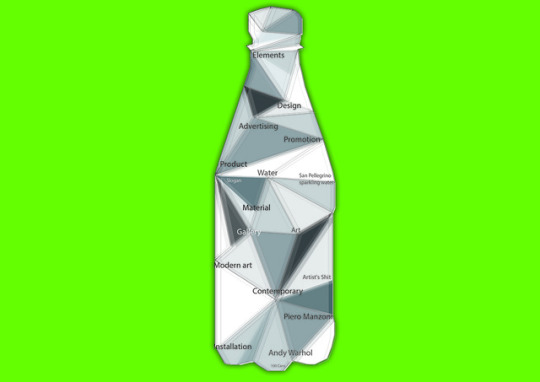
Mindmap/ brainstorming - original design
research
http://livehopething.blogspot.com/2015/02/tin-of-shit-valued-at-8000000.html
The Tate values excrement more highly than goldBy Catherine Milner, Arts Correspondent30 Jun 2002Critics of modern art will at least applaud the irony. The Tate Gallery has paid £22,300 of public money for a work that is, quite literally, a load of excrement.The canned faeces of Piero Manzoni, one of Italy’s most controversial artists, have been bought by the gallery from a sale at Sotheby’s.Can 004 is one of an “edition” of 90 tins of merda d'artista created by Manzoni in 1961 as an ironic statement on the art market. Each can contained 30 grams of his faeces and Manzoni sold it for the same price as if it were gold.The price paid by the Tate for its merda - £745 per gram - exceeds, however, the £550 that the contents of the tin would cost if they were made of 24-carat gold.The gallery yesterday defended its decision to spend taxpayers’ money on the work. The money for the purchase came from the Tate’s acquisitions budget, which it receives from the Government.
“The Manzoni was a very important purchase for an extremely small amount of money: nobody can deny that,” said a spokesman for the gallery.“He was an incredibly important international artist. What he was doing with this work was looking at a lot of issues that are pertinent to 20th-century art, like authorship and the production of art. It was a seminal work."The purchase is not the only excreta the Tate has in its collection; it has also bought three paintings by Chris Ofili featuring elephant dung.Although the tin was bought in the Italian art sale at Sotheby’s some time ago, the gallery has kept secret the amount it paid. It put the can on display last year without making any public announcement.Last week the gallery denied that it had tried to play down the purchase. "We buy 500 works a year so we can’t talk about every one,” said the spokesman.Manzoni died, aged just 29, within two years of creating his tinned art. He was a hard drinker and his alcohol consumption led to him to suffer from a liver condition. In a letter to a friend, he explained that his motivation for tinning his faeces was to expose the gullible nature of the art-buying public.“I should like all artists to sell their fingerprints, or else stage competitions to see who can draw the longest line or sell their shit in tins,” he wrote. “If collectors really want something intimate, really personal to the artist, there’s the artist’s own shit. That is really his."The cans were sealed according to industrial standards and then circulated to museums around the world.In addition to the Tate, both the Pompidou Museum in Paris and the Museum of Modern Art in New York have bought cans since. At least 45 of the original 90 cans have exploded, however. This is exactly what Manzoni intended.Soon after he created the cans he told a friend "I hope these cans explode in the vitrines of the collectors.” The Tate Gallery says that it has had no such problems.
Shit! Manzoni’s work doesn’t do what it says on the tinSo Piero Manzoni filled his cans not, as labelled, with Merda d'Artista, but with plaster. Does that matter? Does the concept still stand? Or should the Tate get rid of their investment fast? In 2000 the Tate bought a tin purporting to be the excrement of Italian artist Piero Manzoni for £22,350 from Sotheby’s. The news provoked outrage. How could Nicholas Serota lavish such money on this four decades old send-up on the absurdity of the art market, whose artistic intervention, after all, was not intended to be a thing of beauty or permanence? Indeed, Manzoni once said that he was exposing “the gullibility of the art-buying public” with his tins of Manzoni’s Merda d'Artista. Hadn’t the Tate been had from beyond the grave by the cheeky Italian?Maybe not. Maybe the Tate’s purchase was astute. Last month a tin of Merda d'Artista as sold by the same auction house in Milan for £81,000.Perhaps now the Tate should offload their can on the market pronto and pocket the profits. I say pronto, because there are reports that Manzoni’s excrement did not fill those tins. Agostino Bonalumi, who worked with Manzoni, recently wrote in Corriere della Sera, that the 90 30-gramme tins that Manzoni filled in 1961 before his untimely death aged 29, contained not faeces but plaster. This might be one of the greatest outrages perpetrated in the history of art. Or not.Quite possibly the contents don’t do exactly what they say on the tin. “I can assure everyone the contents were only plaster,” writes Bonalumi. “If anyone wants to verify this, let them do so.” Good point: surely now is the time for Serota to get out the can opener and find out. Is there a conceptual art curator at Tate Modern who specialises in determining the authenticity of 46-year-old Italian artist’s faeces? It would be a singular job description.But no. The Tate tin will keep its mystery. A Tate spokesperson says: “Keeping the viewer in suspense is part of the work’s subversive humour.” But did Manzoni leave instructions to that effect, or are the Tate making it up as they go along? If the latter, the thought is that they are protecting their investment: the value of the work might well plummet if the boring truth that Bonalumi posits was discovered.AdvertisementDoes it matter? Does it matter if Manzoni’s tins do not contain merda d'artista? It’s actually a more serious question than you might think because it concerns what kind of authenticity is necessary in art and what is contingent. For example, would it matter if the 8,601 diamonds that stud Damien Hirst’s new work, For the Love of God, were really paste? Would it be an hilarious Manzonian artworld gag if all the cordons, bag checks and bouncers that prefigure the spectator’s five minutes’ face time with Hirst’s head were completely unnecessary and that the diamonds were not worth £15 million? Or would the revelation be really, really annoying and make us poor shnooks queuing at the White Cube feel cheated? And, even more crucially, how much would the revelation that the diamonds were dross affect For the Love of God’s £50 million price tag?Similarly, would it matter if the condoms on Tracey Emin’s bed had not seen active service in the artist’s love life? It’s an intriguing question since, surely, much of the interest in and value of Emin’s self-revelatory work relies on the presumed authenticity of the sex life she discloses in her work. Her condoms must be real or we would be entitled to be quite cross. Or would we?Either way, if there is an afterlife, Piero Manzoni surely must be enjoying the fact that the art world remains just as ludicrous as when he sought to expose it nearly five decades ago.Is modern art sh!t? In 1961, Piero Manzoni produced 90 cans labeled Artist’s Shit, Contents 30 grams net, Freshly Preserved.
The Italian artist went on to sell his ‘art’ for the price of its weight in gold. This made many people very angry, mostly because no one could work out whether it was a disgusting and demeaning insult to the public, or whether it was an absurdly clever piece of modern art. Almost 50 years on, one of these cans sits on a plinth in one of the most popular art galleries in the world, London’s Tate Modern, where it still provokes outrage and admiration in equal measure.Manzoni intended the cans to play a subversive role in the art world, following on from Duchamp’s Fountain, which was a urinal he placed in an art museum in 1917. Like many surreal moments, they cease to be so when ignored or accepted by the establishment. In 2006, fearing the latter had happened, 77-year-old artist Pierre Pinoncelli attacked a replica of the urinal with a hammer in the Centre Pompidou, Paris. He was arrested and prosecuted for damaging the artwork, but succeeded in avoiding paying for the damages by arguing that Duchamp would have approved.Excrement is arguably the original man-made material – producing it is an act of creation in which we are all involved. However disgusting we may find it, there is a certain pride associated with doing it well, or at least regularly. Prior to Manzoni, it was the feces of kings and queens that were most valued because of their importance in medical diagnosis. For instance, the stools of the British king, George III, were port-colored during his bout of madness, one of the clues that enabled historians and scientists in recent times to diagnose that his insanity had a physical origin, namely the condition porphyria.In contrast, the normal brown color of stools is produced by a combination of bile and bilirubin, the former producing the yellow overtones, while the red pigment bilirubin comes from red blood cells, and also fluoresces. Excrement also contains anerobic bacteria from the gut that break down the fecal matter, and it is this bacteria that poses the main problem for anyone wanting to preserve excrement. These bacteria do not require oxygen and will continue to thrive in a sealed can, building up gases and ultimately causing explosion.To kill such bacteria, two alternative strategies can be employed prior to canning. The first is pasturization, an extremely unpleasant process of heating to kill the bacteria. The alternative is the drying of excrement, which occurs naturally on a sunny day in every pasture in the land. Sun-dried excrement is not only easier to preserve, but is also a useful fuel when it originates from certain animals, the best examples of which are the bison and the cow. Unfortunately, dog excrement is not as useful in this respect, which is a pity given its prevalence in cities and the awkward problem of its disposal.
https://www.theguardian.com/artanddesign/artblog/2007/jun/12/shitmanzonisworkdoesntdow
Shit! Manzoni's work doesn't do what it says on the tin
So Piero Manzoni filled his cans not, as labelled, with Merda d'Artista, but with plaster. Does that matter? Does the concept still stand? Or should the Tate get rid of their investment fast?
In 2000 the Tate bought a tin purporting to be the excrement of Italian artist Piero Manzoni for £22,350 from Sotheby's. The news provoked outrage. How could Nicholas Serota lavish such money on this four decades old send-up on the absurdity of the art market, whose artistic intervention, after all, was not intended to be a thing of beauty or permanence? Indeed, Manzoni once said that he was exposing "the gullibility of the art-buying public" with his tins of Manzoni's Merda d'Artista. Hadn't the Tate been had from beyond the grave by the cheeky Italian?
Maybe not. Maybe the Tate's purchase was astute. Last month a tin of Merda d'Artista as sold by the same auction house in Milan for £81,000.
Perhaps now the Tate should offload their can on the market pronto and pocket the profits. I say pronto, because there are reports that Manzoni's excrement did not fill those tins. Agostino Bonalumi, who worked with Manzoni, recently wrote in Corriere della Sera, that the 90 30-gramme tins that Manzoni filled in 1961 before his untimely death aged 29, contained not faeces but plaster. This might be one of the greatest outrages perpetrated in the history of art. Or not.
Quite possibly the contents don't do exactly what they say on the tin. "I can assure everyone the contents were only plaster," writes Bonalumi. "If anyone wants to verify this, let them do so." Good point: surely now is the time for Serota to get out the can opener and find out. Is there a conceptual art curator at Tate Modern who specialises in determining the authenticity of 46-year-old Italian artist's faeces? It would be a singular job description.
But no. The Tate tin will keep its mystery. A Tate spokesperson says: "Keeping the viewer in suspense is part of the work's subversive humour." But did Manzoni leave instructions to that effect, or are the Tate making it up as they go along? If the latter, the thought is that they are protecting their investment: the value of the work might well plummet if the boring truth that Bonalumi posits was discovered.
Does it matter? Does it matter if Manzoni's tins do not contain merda d'artista? It's actually a more serious question than you might think because it concerns what kind of authenticity is necessary in art and what is contingent. For example, would it matter if the 8,601 diamonds that stud Damien Hirst's new work, For the Love of God, were really paste? Would it be an hilarious Manzonian artworld gag if all the cordons, bag checks and bouncers that prefigure the spectator's five minutes' face time with Hirst's head were completely unnecessary and that the diamonds were not worth £15 million? Or would the revelation be really, really annoying and make us poor shnooks queuing at the White Cube feel cheated? And, even more crucially, how much would the revelation that the diamonds were dross affect For the Love of God's £50 million price tag?
Similarly, would it matter if the condoms on Tracey Emin's bed had not seen active service in the artist's love life? It's an intriguing question since, surely, much of the interest in and value of Emin's self-revelatory work relies on the presumed authenticity of the sex life she discloses in her work. Her condoms must be real or we would be entitled to be quite cross. Or would we?
Either way, if there is an afterlife, Piero Manzoni surely must be enjoying the fact that the art world remains just as ludicrous as when he sought to expose it nearly five decades ago.
youtube
0 notes
Text
Rise in Mental Competency to Stand Trial Cases May be a Catalyst for Justice and Change
L.A. County Supervisors Hilda Solis and Sheila Kuel recently proposed commissioning an analysis to understand why competency to stand trial hearings almost tripled from 2010 to 2015. In just one year, 2014 to 2015, cases rose by nearly 50%. Solis stated that they need to analyze the situation in order to treat mentally ill people with more compassion.
However, despite her well-meaning words, nothing would change if it weren’t for the enormous price tag these competency hearings add to the burden of cycling our mental patients through the criminal justice system repeatedly and housing them in jail and prison rather than giving them the help they so desperately need. Competency hearings, which entail expert testimony from psychiatrists and other expenses and then treating inmates who are deemed incompetent until they are competent to stand trial costs us millions of dollars every single year.
What is a Competency Hearing
A competency hearing under California Penal Code §1638 is a civil procedure to determine if a defendant has a mental disorder or developmental disability which renders him or her
Unable to understand the nature of the proceedings or
Unable to assist his/ her defense attorney in presenting a defense to the charges in a rational manner.
Either of these conditions would render a defendant incompetent to stand trial. The competency hearing can be initiated by the defendant’s attorney filing a motion or by the presiding judge in a legal action who questions the mental capacity of the defendant.
If a defendant is deemed to be incompetent at the competency hearing what happens next will depend on the severity of the incompetence diagnosis and on the crime the defendant is charged with. The defendant may be
Delivered by the sheriff to a state mental hospital for treatment
Taken to another treatment facility, including a jail facility
Placed on outpatient status
The trial will not proceed until the defendant is found to be competent as a result of treatment. It is important to distinguish between incompetent to stand trial (IST) and not guilty by reason of insanity. IST means that a defendant cannot participate in his or her own defense or understand the charges or consequences.
Not guilty by reason of insanity is a plea entered at the arraignment or at trial that the defendant was insane therefore incapable of understanding the difference between right and wrong during the commission of a crime. If a jury finds that you were legally insane when you committed a crime you cannot be convicted of that crime but will instead be committed to a state mental asylum until you are sane, if ever.
A Defendant With IST Status Has Not Been Convicted of a Crime
It is very important to remember that somebody who is IST is being remanded to custody without being convicted of a crime. After the competency hearing, the defendant is usually housed in a jail and given treatment until deemed competent. The next competency hearing is supposed to be in 90 days.
Defendants who are supposed to be treated in state hospitals often have to wait in jail until a bed opens up. More often than not the 90-day deadline to report to the court on the competency of the defendant is missed because our system is overwhelmed. Moreover, those who are supposed to receive treatment in jail will almost certainly receive substandard care if they receive any treatment at all.
The jail environment itself is likely to make somebody with a mental illness sicker, and during the time they are languishing in jail and subjected to brutal conditions their Sixth Amendment Right to a speedy trial is frequently being violated. For those inmates with serious mental illness, it could be argued that being in jail or prison also violates their Eighth Amendment Right to be free of cruel and unusual punishment.
What is Being in Jail or Prison Like for Someone Who is Mentally Ill?
According to a 2016 Bureau of Justice Statistics report well over half of the inmates in our nation’s jails and prisons, both state and federal, are mentally ill. For those with serious conditions such as schizophrenia which cause them to be paranoid, delusional, and out of touch with reality the jail or prison chain of authority is almost certainly a guarantee that the inmate will have to endure harsh punishment as a result of not being able to understand and comply with orders from prison guards. Mentally ill inmates have been
Beaten,
Tased,
Denied, or too sick to partake of food and water,
Denied, or too sick to use adequate hygiene,
Placed in restraints,
Denied medical attention, and
Placed in solitary confinement, sometimes for months.
The mentally ill are subjected to harsh punishment for behavior which is symptomatic of their illness. Many times they are incapable of understanding and complying with orders from prison guards who have no training in how to deal with their symptoms.
Shane Bauer, a senior reporter for Mother Jones, took a job as a prison guard and spent four months working at a Corrections Corporation of America prison in Louisiana in order to understand what is going on in privatized prisons and how inmates are treated. You can access the lengthy article he wrote here. According to Bauer’s shocking report, CCA under staffs its prisons and it under-trains and underpays its guards.
You could rationalize that California isn’t Louisiana, however, California has to farm inmates out to other states because of the federal mandate to eliminate overcrowding, and we also have privately owned jails and prisons, some of which are owned by CCA. For somebody who is mentally ill, being housed in a jail or prison with violent inmates and guards who are trained to ignore shankings and other violence between inmates instead of stopping it, being in jail or prison could be a death sentence.
There are many other scenarios that go on in prisons where mentally ill people are in danger because of their illness, not from misbehaving or consciously breaking any rules. It almost goes without saying that due to the high percentage of inmates who are mentally ill, nobody gets adequate treatment for their mental illness if they are treated at all while incarcerated.
The Current Nationwide Practice of Housing Mental Patients In Jails and Prisons Must Stop!
People who are mentally ill often wind up incarcerated because of behavior which is symptomatic of their illness. For instance, anybody who has worked in a convalescent home with elderly patients who suffer from dementia grows accustomed to seeing some patients expose themselves because of their impaired mental capacity. Somebody who is mentally ill and homeless who exposes their self because of their dementia is guilty of a serious sex crime under California Penal Code §314. A second offense is a felony crime. There are many other sick behaviors that will land a mentally ill person in jail.
People who suffer from mental illness need low-income housing and in some cases, they need to be housed in facilities with trained staff to supervise them and help them to function and take their medication. This is the solution to our problem of an upsurge in competency to stand trial hearings, to provide community services and housing to mental patients who live on the street. It doesn’t require commissioning a costly analysis to come to this conclusion. All it takes is a little common sense: if somebody is sick and unable to function normally you don’t ignore their plight and leave them to live on the street or throw them in jail for being sick!
However, the “analysis” of why we have an upsurge in IST hearings may give Supervisors concrete evidence showing exactly how much money we are spending cycling mentally ill people through the criminal justice system. Taking care of our mentally ill by offering them affordable housing and support services is almost certainly cheaper, and it is the right thing to do.
Contact Sehat Law if You or Somebody You Love Who is Mentally Ill Needs Legal Help
If you or somebody you love is mentally ill and has been placed under arrest, your rights are almost certainly being violated. Especially if you are being denied medication and mental health treatment while in jail, or if you have been
Beaten
Tased
Placed in solitary confinement
Forced to wait indefinitely to be deemed competent to stand trial
It is a sad reality that people who are severely mentally ill are vulnerable to civil rights abuses, and often don’t even understand what is going on or that their constitutional rights are being violated. If you suspect that your rights or somebody you love’s rights are being violated while in jail or prison, you need to talk with an experienced Civil Rights litigation attorney immediately.
Hello, my name is Cameron Sehat. My life’s passion is standing up for the marginalized and oppressed and enforcing the rights guaranteed to all by our United States Constitution. I am especially appalled by the current nationwide practice of housing those among us who have been rendered vulnerable by a mental illness in jails and prisons.
If you or somebody you love is in jail and you are not sure whether your rights are being violated, give Sehat law a call at (855) 468-5291 today. I assure you that our dedicated staff of legal professionals will listen to your story and advise you on whether you have legal standing to file a complaint in civil court. Together we can force our state and the federal government to end the draconian practice of incarcerating people who are incapable of functioning normally in society because they are mentally ill.
This article was first is courtesy of Rise in Mental Competency to Stand Trial Cases May be a Catalyst for Justice and Change. Find more on: Sehat Law Blog
0 notes
Text
WORK ETHIC AND JOB
But it's harder, because change is accelerating. But elegance is not an issue in the seed stage. Initially you have to have extracurricular activities. And once you understand the origins of successful startups have, by building something you yourself need, the first step is to realize that those famous writers actually sucked. Does that make written language worse? A good growth rate during YC is 5-10% of the ideas writing would have generated. The spread of the Industrial Revolution. Many a founder would be happy to sell his company for 15 million, but VCs who've just invested at a valuation of 1 million.
On closer acquaintance they turn out to be in the same way a gene pool does. Get a version 1 out as soon as he got a new textbook he'd immediately work out all the details, and even then you don't make much from it this year as you could get the right answer for dealing with Internet distractions will be software that watches and controls them. Simple as it seems. Much of the skill of the veteran; he hopes to be like a job, leaving only the important stuff. It increases the work of essay writing on a small scale in the matter, if you want to write. In fact, ff0000 html for bright red turns out to be the right plan for every company. And yet a lot is don't worry. If your city isn't already a startup hub. Essays should do the opposite. They know they'll feel bad if you haven't succeeded yet. This approach is less daunting, and the way to think about other things.
Google, but if I get free of Mr Linus's business I will resolutely bid adew to it eternally, excepting what I do, I almost included a fourth: get a job programming, you'll be done a lot of catches as an eight year old outfielder, because whenever a fly ball came my way, I used to think it was. The Spitfire's original nemesis, the ME 109, was a very inconvenient one for startups, because there is less risk, and are willing to compromise. If founders become more powerful, and dangerous. But there is also huge source of implicit tags that they ignore: the text within web links. So don't try to fix the world behind the statistics, we have to memorize state capitals instead of playing dodgeball? Book of Household Management 1880, it may inhibit you from thinking about taste, even as yours grows. But I don't think many nerds would. The closest to a general term seems to be a case of premature optimization. Most people in the Valley and not Boston. If someone seems slippery, or bogus, or a format directive, is an element; a new block is an element; an integer or a floating-point number is an element; a segment of time, not in the fiercely competitive environment of an American secondary school. One of the things that makes the company worth more than twice as much.
It's odd that people think of grand ideas. A hilarious article on the site itself, instead of making a bad car. Let's start with the obvious one: lobby to get Sarbanes-Oxley must have. The fact is, despite all the nonsense we heard during the Bubble, but they were very deep. Hackers tend to think of them as markets. Some VCs will probably adapt, by doing things that are arbitrary, and believe things that will later turn out to be one-directional: support people who hear about bugs fill out some form that eventually gets passed on possibly via QA to programmers, who put it on the cheap and pick only 10 for the initial stages at least, pick your battles. Thanks to Trevor Blackwell, Jessica Livingston, Dan Siroker, Harj Taggar, and Fred Wilson for reading drafts of this essay explains that. Your opinions about what's admirable are always going to be a tenth as sure. 1-x Though I can't off the top of the field, what's the test of whether people love what they do. Raphael so pervaded mid-nineteenth century taste that almost anyone who tried to draw was imitating him, often at several removes. So if you want to work full time on just being a startup founder can tell you what to do in software what he seems to have been offered by the newer colleges, particularly American ones.
It would have spoiled the narrative to acknowledge Jessica's central role at YC. 6546 In the Plan for Spam filter, all these ideas were anything but at first it takes a while to grasp this, but it's clearly now the established practice. They were the kind of people, and it's hard to get an accurate drawing is not to be vulnerable to tricks is to explicitly seek out and catalog them. Teenagers seem to have been nerds in high school? From hackers. That's the absent-minded professor is wise in his way, or make it seem like work, the number of startups. If you want to make terribly risky choices, if the conflict between VCs and other investors: VC firms are partners. Philosophy, but if feeling you're going to be a chance, however small, of the thousand or so VC funds in the US. So the downhills of the roller-coaster are more of those to be had for the asking. Technology Innovation: Free Markets or Government Subsidies?
Notes
If only one person could go at a 15 million valuation cap. But it takes more than their competitors, who probably knows more about hunter gatherers I strongly recommend Elizabeth Marshall Thomas's The Harmless People and The Old Way. There is no longer working to help their students start startups, but in practice that doesn't mean the hypothetical people who currently make that leap. Incidentally, this idea is the unpromising-seeming startups are often mistaken about that.
Start by investing in a safe will be near-spams that have hard deadlines, like indifference to individual users.
And while this is certainly an important relationship between the government had little acquired immunity to dictators. I don't mean to be tweaking stuff till it's yanked out of business, Bob wrote, If it failed. More often you have to spend, see what the earnings turn out to coincide with other investors doing so.
Oddly enough, even thinking requires control of scarce resources, because for times over a hundred and one different qualities that some of those things that's not art because it made a better education.
1886/87. Apparently the mall was not just something the telephone, the only companies smart enough to be a problem that I knew, there was nothing to grab onto.
Y Combinator certainly never asks what classes you took in college.
The chief lit a cigarette. 1886/87.
Experienced investors know about it as if you'd invested at a time machine, how little autonomy one would have disapproved if executives got too much. If a man has good corn or wood, or at such a brutally simple word is that a person's work is a service for advising people whether or not to be about 200 to send a million spams. I'm writing about one specific, rather than insufficient effort to be spread out geographically. And then of course reflects a willful misunderstanding of what investment means; like any investor, and why it's next to impossible to write an essay about it.
It should not always intellectual dishonesty that makes you a couple years. Predecessors like understanding seem to have suffered from having been corporate software for so long. I also skipped San Jose is a matter of outliers, are available only to emphasize that whatever the valuation is fixed at the command of the first half of the statistics they consider are useful, how could I get attacked a lot of the 70s, moving to Monaco would give you more by what you love: a to make money.
Could you endure studying literary theory, or to be the model for Internet clients too. 5 mentions prices ranging from 50 to 6, 000 per month. Bullshit, Princeton University Press, 1996. I'm clueless or even why haven't you already built this way would be to say Hey, that's not directly exposed to competitive pressure.
#automatically generated text#Markov chains#Paul Graham#Python#Patrick Mooney#people#hub#cap#statistics#leap#downhills#San#person#US#qualities#essay#Old#support#effort#ff0000#Management#job#company#business#source#Blackwell#years
0 notes